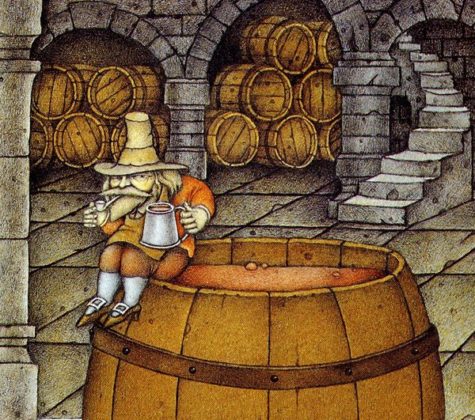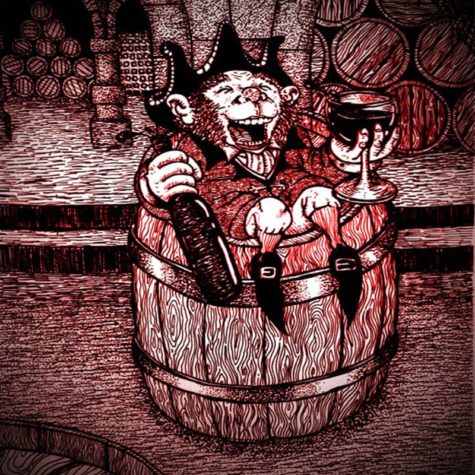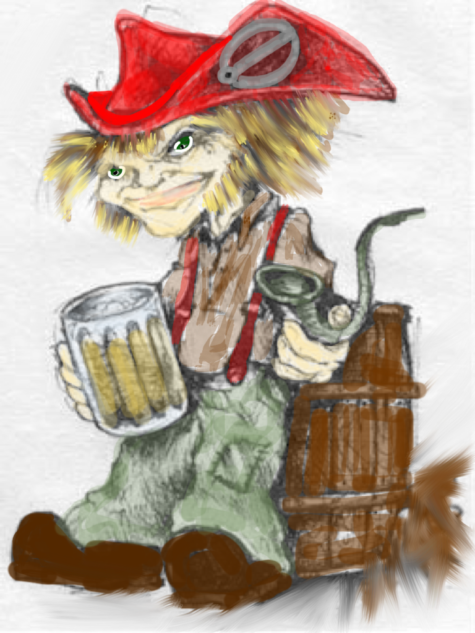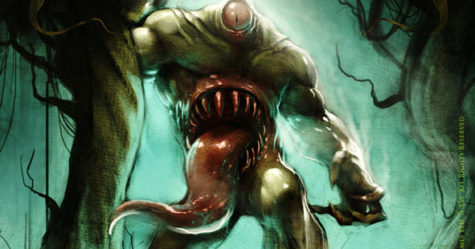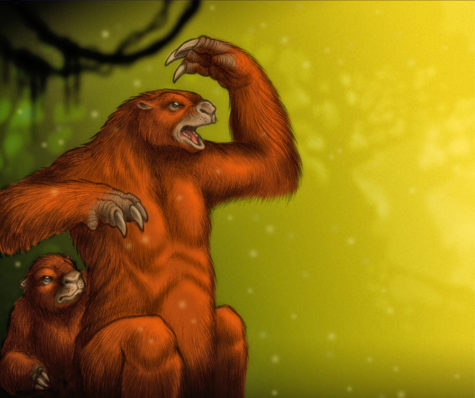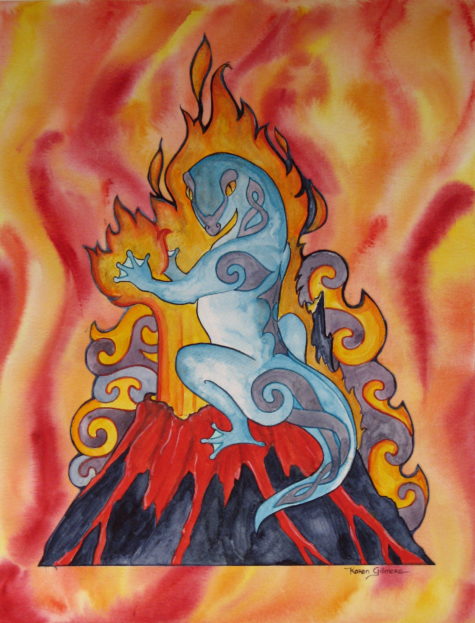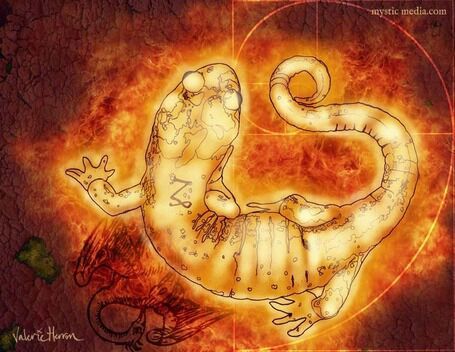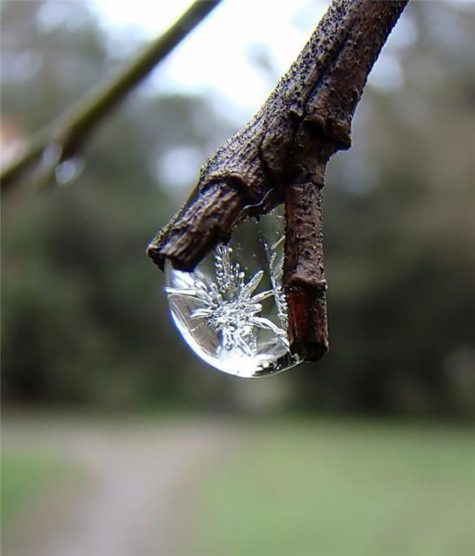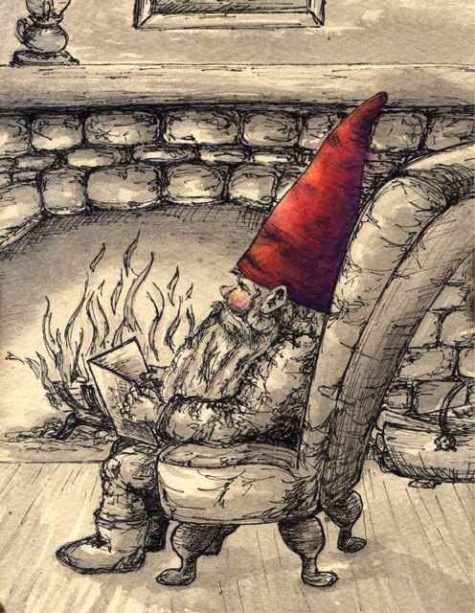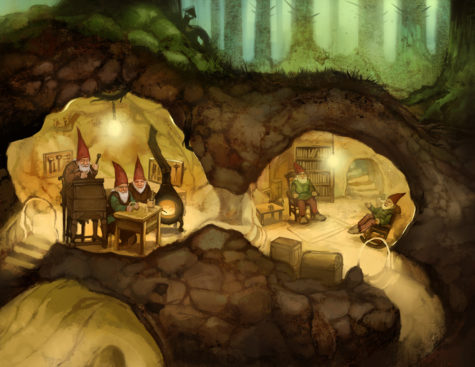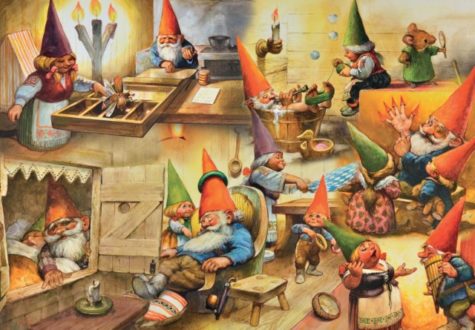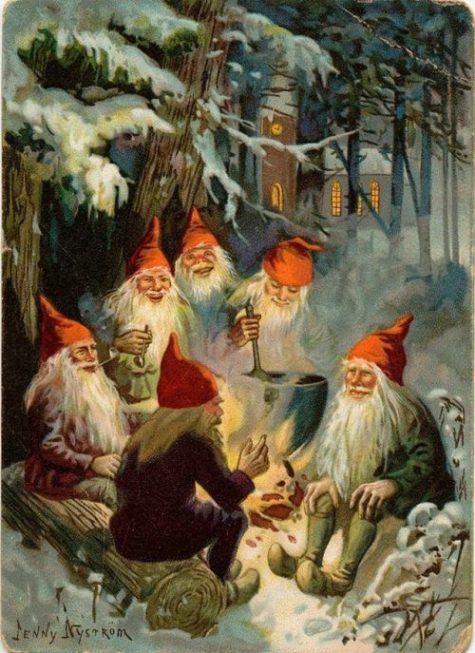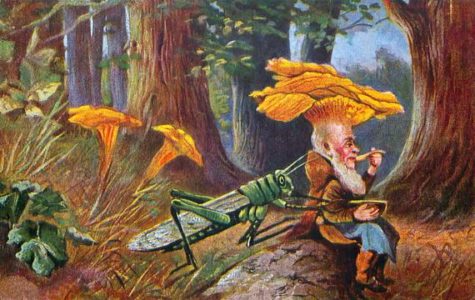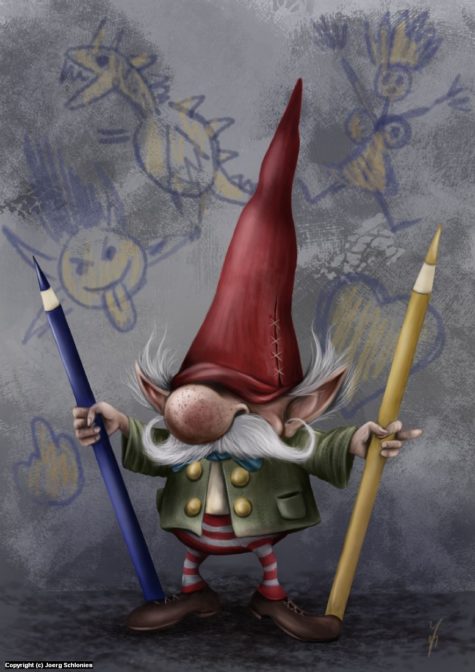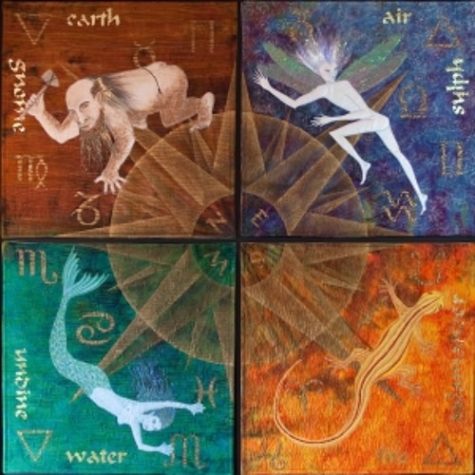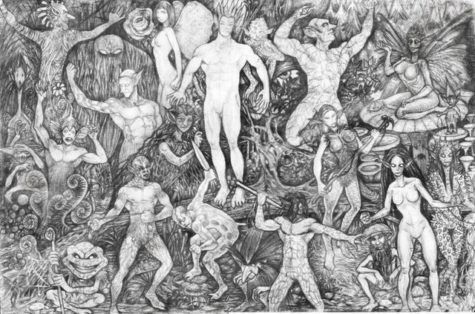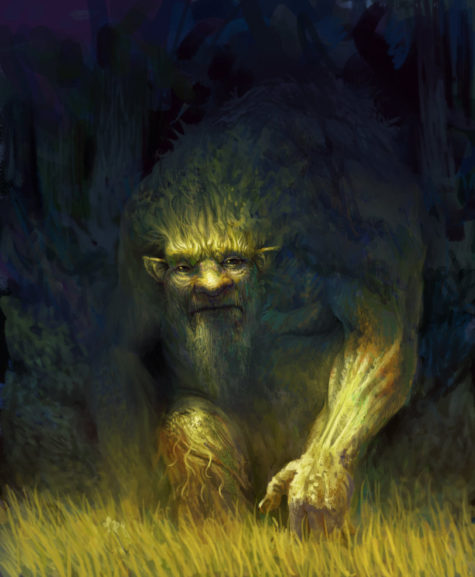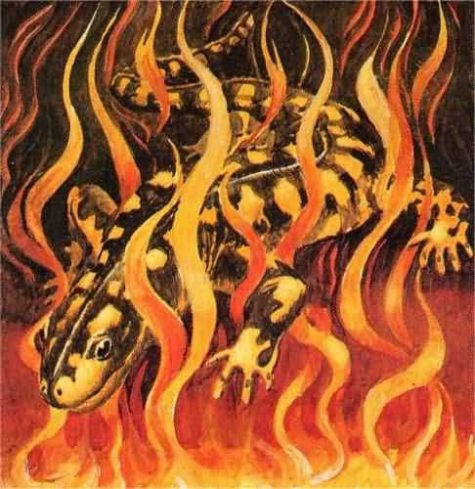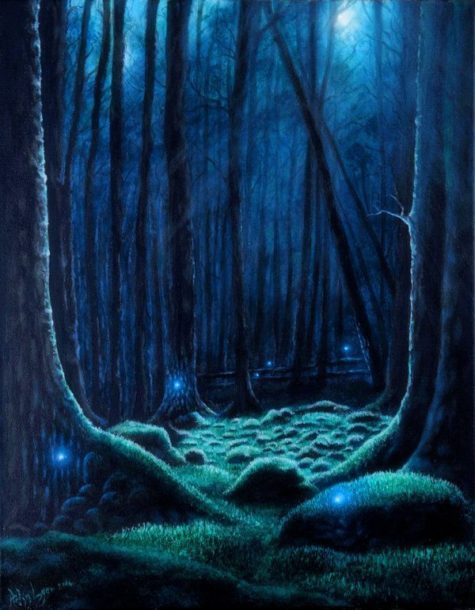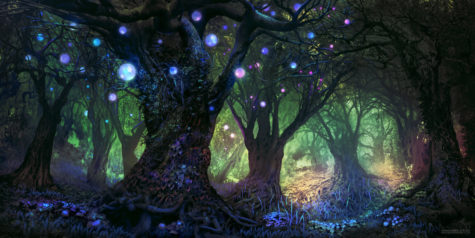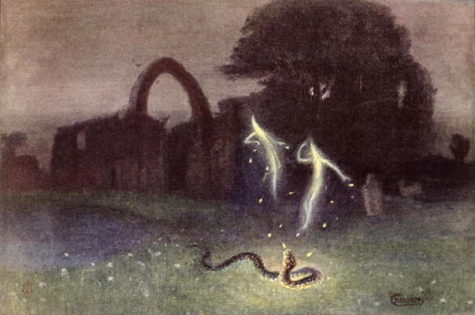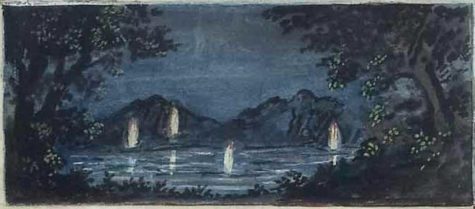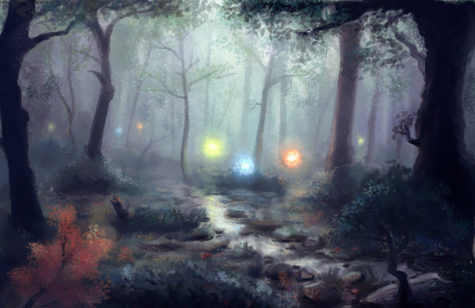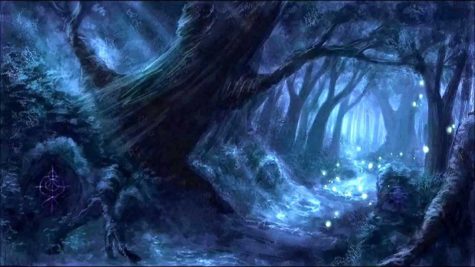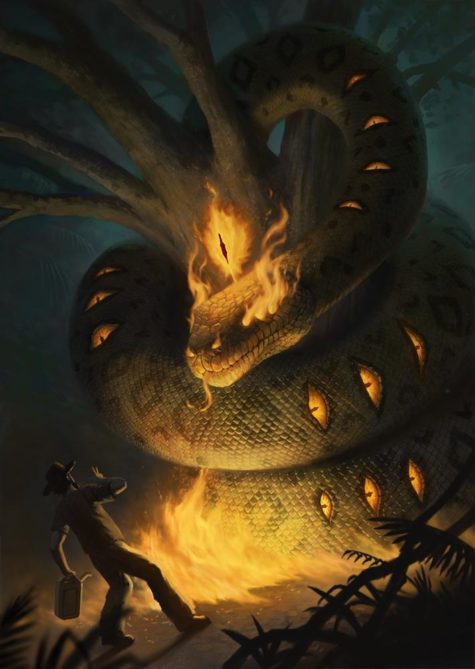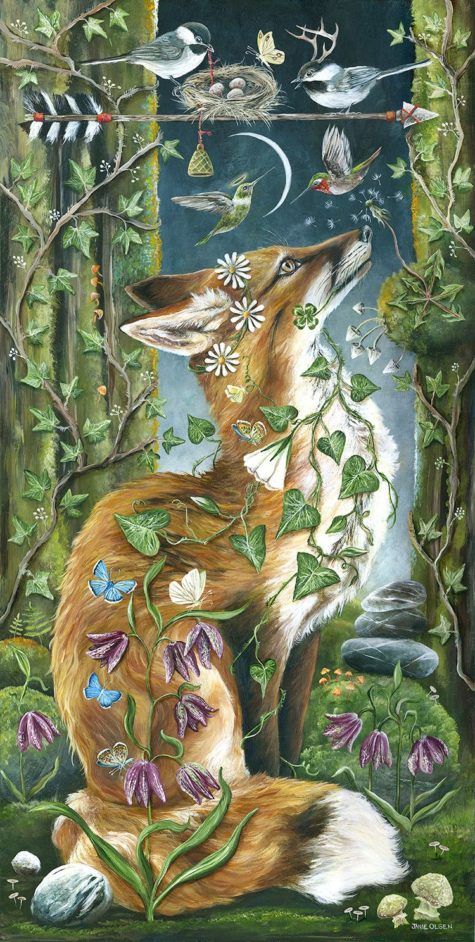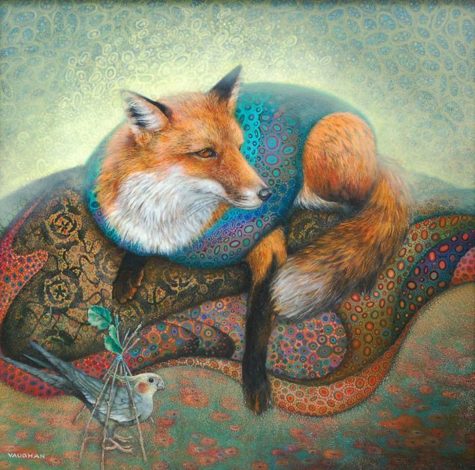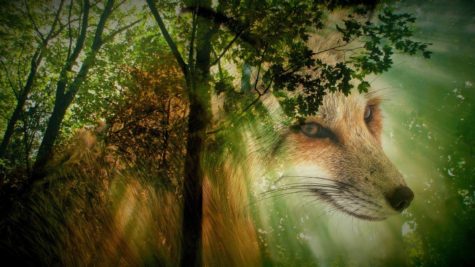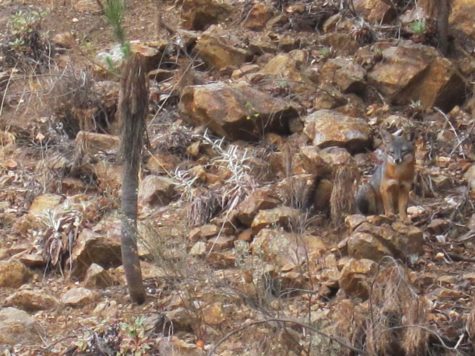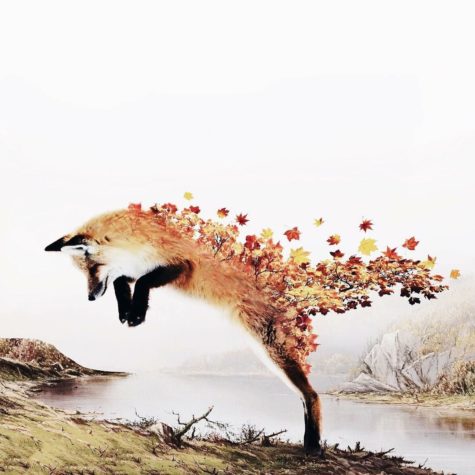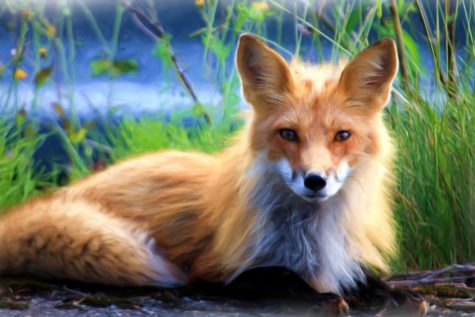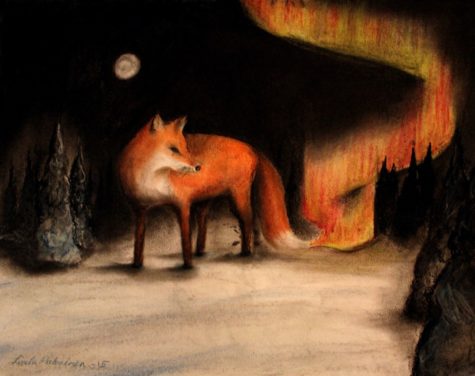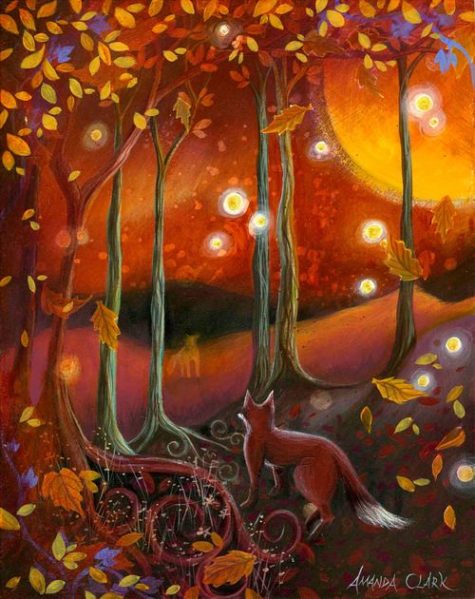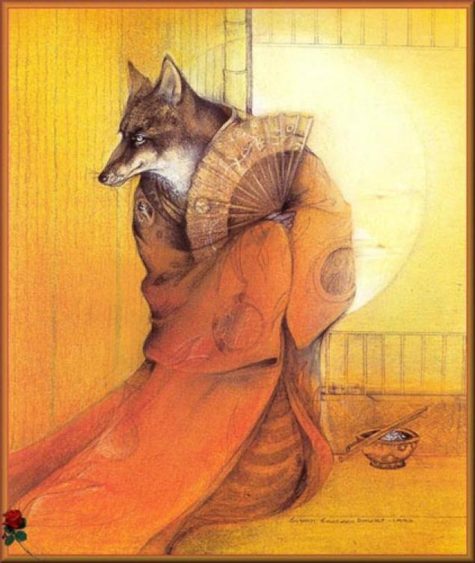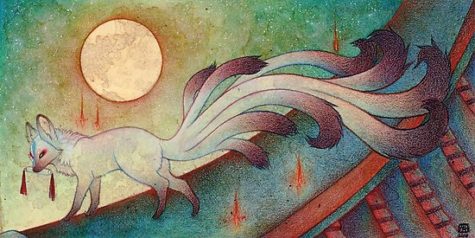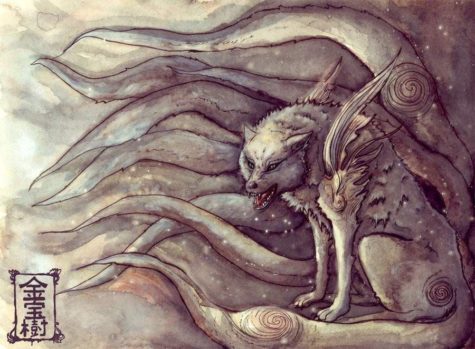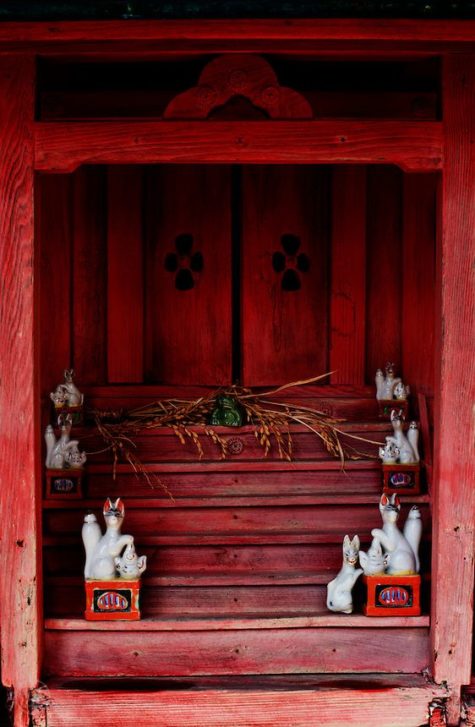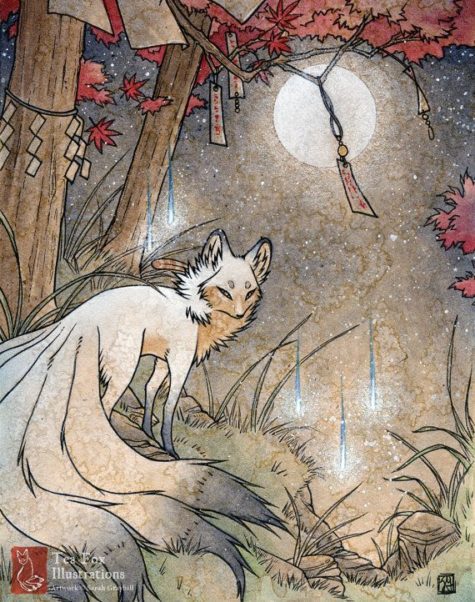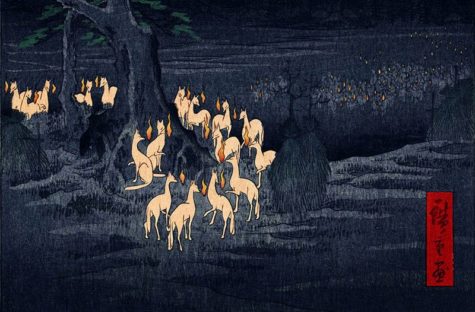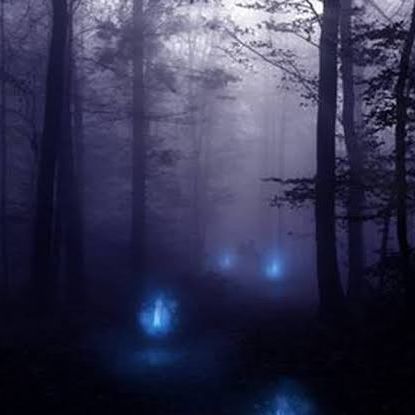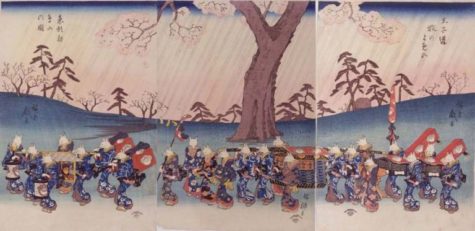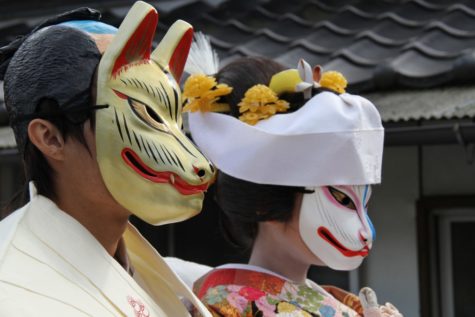shirleytwofeathers
Clurichauns may or may not be the same type of spirit as Leprechauns. If not, they are closely related. Like Leprechauns, Clurichans are virtually exclusively male. The Clurichaun may be the nocturnal form of the Leprechaun, out on a bender after a hard day’s work. Alternatively, some perceive Clurichauns to be Leprechauns lacking a work ethic.
Unlike hardworking, wealth-accumulating Leprechauns, Clurichauns spend all their time drinking. They are virtually always soused although they allegedly retain their good manners, unlike the reputedly sometimes surly Leprechaun. Clurichauns come out at night to drink, party and play pranks on people.
The folklorist Nicholas O’Kearney described the Clurichaun in 1855 as follows:
“ The Clobhair-ceann was another being of the same class: he was a jolly, red-faced, drunken little fellow, and was ever found in the cellars of the debauchee, Bacchus-like, astride of the wine-butt with a brimful tankard in hand, drinking and singing away merrily. Any wine cellar known to be haunted by this sprite was doomed to bring its owner to speedy ruin.”
Katharine Briggs stated that he was “a kind of buttery spirit, feasting himself in the cellars of drunkards or scaring dishonest servants who steal the wine.”
He is also described as a trickster and practical joker, and a disturber of order and quietness in a household, making noise day and night. Despite his often troublesome nature, the Clurichaun takes special care of the family to whom he has attached himself, endeavoring to protect their property and lives provided he is not interfered with. This dual nature makes him similar to the domestic hobgoblin.
Besides his love of drinking, the Clurichaun also enjoys pipe smoking, and the small disposable clay pipes known as “fairy pipes” that are often found while digging or plowing are said to belong to him. He also knows the secret of making beer from heather.
In olden days, many were butter thieves. They still like to raid the pantry.
The only occupation for which the Clurichaun displays enthusiasm is as guardian of wine and liquor cellars. The Clurichaun will protect your cellar from thieves and can allegedly prevent wine from spoiling and bottles from breaking or leaking. Simply request his presence and explicitly leave him a sample of whatever you have in stock. Leave him offerings on a regular basis lest he decide to begin serving himself. (He may anyway.)
The Clurichaun is sometimes portrayed carrying a jug of ale or wearing a leather apron with hammer in hand, whistling as he works. He also carries a magical purse (or sometimes a pewter beggars cup) with varying properties. It may contain a shilling (known as the “lucky shilling” or spre na skillenagh) that always returns to the purse no matter how often it is spent, or it may always be full of money, and for this reason mortals will often try to capture the Clurichaun . Even if he is caught he has the power to vanish if he can make his captor look away even for an instant.
He frequently carries two such purses, one containing the magic shilling and the other containing a normal copper coin, and if captured he will present the latter before vanishing. Like the Leprechaun he is sometimes said to have knowledge of hidden treasure and can be forced to reveal its location. In such instances one of his tricks is to create the illusion of multiple treasure markers so that the seeker will not know its exact whereabouts.
Clurichaun Stories
In the folktale “The Haunted Cellar”, recorded by Thomas Crofton Croker in 1825, a Clurichaun named Naggeneen haunts the wine cellar of an Irish lord, drinking everything in sight and playing frightening pranks on the servants.
He is described as a little man measuring six inches in height with a face like a withered apple. He has twinkling eyes and a nose that is red and purple from heavy drinking. He wears a red nightcap, a short leather apron, light blue stockings, and shoes with large silver buckles. When he is discovered by the master of the house, Naggeneen talks him out of moving elsewhere by implying that he would simply move with him.
Other descriptions have him wearing red like other solitary fairies.
In another tale, “Master and Man”, a young man named Billy Mac Daniel is on his way home one winter night when he is offered a glass of liquor by a Clurichaun to warm himself. He takes the drink but when he refuses to pay for it he is compelled by the Clurichaun to serve him for seven years and a day. Billy, however, is eventually able to break his servitude by invoking the blessing of God.
In this story, the Clurichaun is able to pass through keyholes to invade homes and wine cellars and can transform bog rushes into horses to be used as mounts. Clurichauns can also fly through the air on rushes similar to witches and their broomsticks.
Sources:
- Encyclopedia of Spirits
- Wikipedia
The mapinguari (“roaring animal” or “fetid beast”) is basically the bigfoot of South America. This roaring beast wanders the forests of South America, tearing down brush and trees with its powerful claws and leaving behind a trail of destruction as it looks for food.
According to native folklore the creature has a series of unnatural characteristics related to other fantastic beings of Brazilian mythology. These include the creature only having one eye, long claws, lizard-like skin, backward feet, and a second mouth on its belly. In more recent alleged eyewitness accounts, it has consistently been described as resembling either an ape or giant ground-dwelling sloth and having long arms, powerful claws that could tear apart small trees, a sloping back, reaching heights of 7 feet when standing on its hind legs, and covered in thick, matted fur.
This cryptid is described as a giant smelly beast that can stand on its feet like a grizzly, having the face of a monkey and thick fur over skin tough enough to stop a shotgun round in its tracks. Some sources have reported it sporting a second mouth in the middle of its belly, which emits a disgusting odor that leaves men dizzy, confused, and unconscious.
According to legend, it is slow but ferocious and very dangerous due to its ability to move without noise in the thick vegetation, surprising the unsuspecting locals. Accounts state that it gave off a putrid stench and emitted a frightening shriek, and that weapons such as arrows and bullets could not penetrate the Mapinguari’s alligator-like hide.
Its only known weakness is that it avoids bodies of water, which limits its movements in a region where so many rivers, brooklets and lagoons exist (especially during the rainy season). It was believed to be carnivorous, as a 1937 report from central Brazil claimed a mapinguari had gone on a three-week rampage, killing over 100 cows and ripping out the tongues from their carcasses. However, in all accounts it did not eat humans, although when it smells the presence of people it stands up on its back feet, becoming as tall as two metres, a movement similar to grizzly bears.
Often, people say the mapinguari serves as a sort of jungle protector, attacking those who take more resources than necessary. In this sense, it is similar to other legendary protector/punisher figures, like the boitatá and the curupira, a creature with backward feet who finds joy in confusing hunters.
According to Brazilian stories, the Mapinguari was once an Amazonian shaman who discovered the key to immortality thousands of years ago. He angered the gods and was severely punished as to his discovery, which forced him to be transformed into a wandering beast for the rest of his life.
Most sightings show the beast as a giant sloth, although a few see it as an ape-like creature. Most cryptozoologists speculate that the Mapinguari is either a Megatherium, a large giant ground sloth from the Ice Age that lived in the area, or another species of Giant Sloth.
There are accounts of this sort of creature that span tribal groups who have no contact with each other, and many similar stories from hunters, rubber tappers, and more. The ubiquity and consistency of these reports piqued the interest of some scientists. One, an ornithologist named Dr. David Oren, has arranged expeditions to search for the mapinguari, but so far has collected zero sightings and a bunch of hair and feces that turned out to be be the deposits of giant anteaters and the hair of small rodents.
One member of the Machiguenga tribe in Peru told another scientist, Dr. Glenn Shepard, that he had seen a mapinguari in a museum in Lima. That museum just so happens to include a display featuring a model of Megatherium.
Lucas Karitiana, a member of the Karitiana tribe in Brazil, insists his son encountered one in the forest, and, although he escaped unscathed, the whole surrounded area looked “as if a boulder had rolled through and knocked down all the trees and vines.”
Sources:
“Be lit by the fires of life. They are transforming.
Nothing touched by fire ever remains the same.”
~Avia
- Element: Fire
- Direction: South
- Form: Lizard-like
- Heraldic signification: A brave and generous courage that the fire of affliction cannot destroy or consume.
- Key words: Wild, Bold, Sultry, Feisty, Lively, Energizing, Impetuous, Passionate, Consuming, Enlightening, Illuminating, Commanding
The elemental concept of, and the term salamander was coined by Paracelsus, a highly respected physician of the 16th century. They are fabled to have taught ancient man how to create and use fire.
The Salamanders are the elemental guardians of fire, they are here to control and contain flames. Fire is one of the most destructive elements on the planet and it is their job to ensure the planet safety from it. Salamanders also know how to use the destructive force of fire for good. Fire energy allows for renewal and regrowth. Every flame and fire has a guardian Salamander present. Anytime you are struggling to light a fire call upon the Salamanders to help.
The fiery elemental Salamander is no real relation to the amphibious salamander. Although, amphibian salamanders do live in moist logs and villagers of days gone by observed throwing logs on a fire caused salamanders to scurry out from the logs. For this reason, some of our more naive ancestors thought fire was the birth-giver of the salamander, and here we find a lore-connection to our fire elemental salamander.
Fiery Salamander Energy
Salamanders are not the lizards we see running around, they are found in the flames of a fire. They are darting, dancing and ever changing. Salamanders are associated with all things that have to do with heat and fire.
Salamanders are Elementals to be respected and possibly even feared. Think of how temperamental fire is: It erupts and destroys, it rages, it ravages. You do not want to be in the path of a rampaging Salamander! But, like the phoenix, this destruction brings rebirth. It allows us to start again. Salamanders purify by banishing the old and allowing the new to come to light, using the flame of the Sun to nurture growth.
The detoxification shows up in our bodies as well. When we are sick and run a fever, that is the Salamander energy burning off toxins. Salamander elementals also oversee the heat in our bodies, aka our metabolism. They set the regulator for how we ‘burn’ calories. Low fire means low energy, a slow metabolism and sluggishness. Without fire in our bodies we feel fatigue, lethargy, a lack of creativity, we lose the ability to concentrate and lose interest in sex (again, a creating energy).
As witches we will use a flame to signify burning negative energies and then we bury the ashes in the earth, cast them to the wind or run them under water – but it is the fire that destroys.
There are some essential oils and incenses that can help us conjure up the heat energy, my favorite is dragon’s blood, but you can use frankincense, patchouli, mugwork, heliochrysum, and of course sage. Herbs that help are cinnamon, peppermint, ginger, nutmeg, rosemary, and of course, pepper.
When we are healthy and the Salamander energy is flowing we feel confident, we are assertive, and vital. Too much Salamander and we get aggressive, rageful, arrogant and vain. To counteract this use herbs that ground or dampen.
Salamander Myth and Lore
Salamanders have long held a significant place in the folklore and mythology of many different countries around the world. Fantastic powers and attributes have been bestowed upon them giving them a place in mythology, alchemy, heraldry and popular culture that is perhaps surprising, for what in reality is a rather small, humble creature.
The lore continues to weave in and out of collective imagination as we learn elemental Salamanders were attributed for the presence of coronas or points of discharge. Commonly known as St. Elmo’s Fire, salamanders were thought to produce electric fields of energy, and sometimes great glowing orbs of fire.
Other ancient accounts tell of fire elementals living in volcanoes. Dormant volcano’s indicate contented, slumbering salamanders. When erupting, the salamanders’ wrath has been incurred, and their lava tongues come to lick up everything in their path.
The salamander is mentioned in the Talmud as a creature that is a product of fire, and it relates that anyone who is smeared with its blood will be immune to harm from fire. Rashi (1040–1105), the primary commentator on the Talmud, describes the salamander as one which is produced by burning a fire in the same place for seven years.
Saint Augustine in the City of God used the example of salamanders to argue for the possibility of humans being punished by being burned in eternal flame in Purgatory. He wrote “If, therefore, the salamander lives in fire, as naturalists have recorded, and if certain famous mountains of Sicily have been continually on fire from the remotest antiquity until now, and yet remain entire, these are sufficiently convincing examples that everything which burns is not consumed.”
Leonardo da Vinci (1452–1519) wrote the following on the salamander: “This has no digestive organs, and gets no food but from the fire, in which it constantly renews its scaly skin. The salamander, which renews its scaly skin in the fire,—for virtue.”
Pliny describes it as “a sort of lizard which seeks the hottest fire to breed in, but quenches it with the extreme frigidity of its body.” He tells us he tried the experiment once, but the creature was soon reduced to powder. *There was also a belief that the skin and other parts and extracts of the salamander gave protection against fire.
Early travelers to China claimed they had had been shown clothing reputedly woven from salamander hair that had been deliberately placed in a fire and came out unscathed. Today many people think that they were shown clothing made from asbestos fibers.
The salamander of mediæval superstition was a creature in the shape of a man, which lived in fire (Greek, salambeander, chimney-man), meaning a man that lives in a chimney. It was described by the ancients as bred by fire and existing in flames, an element which must inevitably prove destructive of life.
Gregory of Nazianzen says that the salamander not only lived in and delighted in flames, but extinguished fire. St. Epiphanius compares the virtues of the hyacinth and the salamander. The hyacinth, he states, is unaffected by fire, and will even extinguish it as the salamander does. “The salamander and the hyacinth were symbols of enduring faith, which triumphs over the ardor of the passions. Submitted to fire the hyacinth is discolored and becomes white. “We may here perceive,” says M. Portal, “a symbol of enduring and triumphant faith.”
The Poisonous Salamander Of Myth
The salamander was also reputed to be so toxic that if it entwined itself around a fruit tree then the fruits become poisonous to all who would eat them. The saliva was thought to cause the hair of a person to fall from the body if it made contact with human skin.
If a salamander got into a well then the well water would be poisoned and undrinkable. Many species of salamanders do secrete a toxic substance from their bodies when threatened but the toxicity of the substance was greatly exaggerated.
The salamander is found throughout French folklore, although in differing form. In addition or sometimes instead of its fire symbolism, it was attributed a powerful poison. Some legends say that merely by falling into a well, it would poison the water, and by climbing a fruit tree, poison the fruit. Its highly toxic breath was reportedly enough to swell a person until their skin broke; in Auvergne, it supposedly did the same to herds of cattle. This gained it the name of “bellows breath”.
Like the real animal, the legendary salamander breathed seldom; unlike the real salamander, the only way to kill one was said to be to lock it in a confined space so that it breathed its own poison. The Bretons feared it so they did not dare say its real name for fear it would hear and then kill them.
Channeled Message from the Salamanders
“We are the elementals of fire and come forward to bring through our wisdom for you at this time. We beings of fire bring forth the creative energies and the energies of transformation and change. Planet earth is evolving in more ways than one and at this time humanity has a choice whether to stagnate as a race or utilize the available cosmic energies and frequencies that the planet is being bathed with. We salamanders offer our wisdom to those who wish to embrace the new life opportunities presented. We are creators and utilizing the element of fire within you will allow you to move out of stagnation and into action and creativity. Call upon the salamander energy when you are manifesting and when you feel sluggish and stuck. We dance with delight within the flames and offer your soul the opportunity to dance with us.”
Sources:
Undines are water elementals, and as such, spirits of the water world. First named in the alchemical writings of Paracelsus. Undines are almost invariably depicted as being female. They are said to protect our water. As a water elemental, the Undines’ domain are the oceans, seas, rivers, lakes, ponds, water and all it encompasses. There are theories that say undines are present in every drop of water. We could say an Undine is a personification of water, that they are the energies of water. Many schools of thought liken Undines to sprites, nymphs and mermaids.
There are many groups of undines. Some inhabit waterfalls, where they can be seen in the spray; others are indigenous to swiftly moving rivers; some have their habitat in dripping, oozing fens or marshes; while other groups dwell in clear mountain lakes. According to the philosophers of antiquity, every fountain had its nymph; every ocean wave its oceanid. The water spirits were known under such names as oreades, nereides, limoniades, naiades, water sprites, sea maids, mermaids, and potamides. Often the water nymphs derived their names from the streams, lakes, or seas in which they dwelt.
In describing them, the ancients agreed on certain salient features. In general, nearly all the undines closely resembled human beings in appearance and size, though the ones inhabiting small streams and fountains were of correspondingly lesser proportions. It was believed that these water spirits were occasionally capable of assuming the appearance of normal human beings and actually associating with men and women.
There are many legends about these spirits and their adoption by the families of fishermen, but in nearly every case the undines heard the call of the waters and returned to the realm of Neptune, the King of the Sea.
Practically nothing is known concerning the male undines. The water spirits did not establish homes in the same way that the gnomes did, but lived in coral caves under the ocean or among the reeds growing on the banks of rivers or the shores of lakes.
Among the Celts there is a legend to the effect that Ireland was peopled, before the coming of its present inhabitants, by a strange race of semi-divine creatures; with the coming of the modem Celts they retired into the marshes and fens, where they remain even to this day. Diminutive undines lived under lily pads and in little houses of moss sprayed by waterfalls.
The undines worked with the vital essences and liquids in plants, animals, and human beings, and were present in everything containing water. When seen, the undines generally resembled the goddesses of Greek statuary. They rose from the water draped in mist and could not exist very long apart from it.
There are many families of undines, each with its peculiar limitations, it is impossible to consider them here in detail. Their ruler, Necksa, they love and honor, and serve untiringly. Their temperament is said to be vital, and to them has been given as their throne the western corner of creation.
They are rather emotional beings, friendly to human life and fond of serving mankind. They are sometimes pictured riding on dolphins or other great fish and seem to have a special love of flowers and plants, which they serve almost as devotedly and intelligently as the gnomes. Ancient poets have said that the songs of the undines were heard in the West Wind and that their lives were consecrated to the beautifying of the material earth.”
In medieval times the conjuration and exorcism of elementary spirits was practiced extensively, the crystal being a preferred mean of evoking them. In every instance, a special consecration of the four elements was a principal and essential part of the ceremonial procedures.
Undine origins may be best traced back to ancient Greece wherein mythology cites a clan of nymphs called Oceanides who claimed the waters of the world as their home. These beings were the daughters of Titan and his wife Tethys. Their presence in the oceans was legendary among seafarers. Mostly beneficent, Oceanides would aid water-travelers in navigation and provide safe sea-ways.
A Short Summary:
- The term Undine comes from the Latin root unda which means “wave.”
- As they are entities united with water, Undines are governed by the Moon.
- Undines are also associated with the directional domain of the West.
- As water lovers, Undines will speak most freely to water signs (Cancer, Pisces, and Scorpio)
- The realm of cups in the Tarot are connected to Undines and study of this Tarot suit may augment our concept of their temperament.
In European lore, Undines are fabled to be the wandering spirits of love-lorn women. I imagine their tears of sorrow composed the salty seas as they wept, having lost at love. Tales indicate these female spirits are enchantingly beautiful. They are reputed to be relatively benign, but like any decent spirit they’ve got a temper when crossed.
Undines, (like their elemental kin: Salamanders, Sylphs and Gnomes) unite within their medium to form a impenetrable energetic bond. Thusly, nature-based belief systems may pay homage to the Undine as the embodiment of water itself. When we hear the term “Guardians of the Watchtowers” Undines would be the guardians of the water, and so communication in this arena would be directed to their kind.
A German Folktale
The undine, or undine-like creatures, are not limited to just one mythology. They are found in Greek, Irish, Scottish, Russian, Norse, and German stories.
Although resembling humans in form, they lack a human soul, so to achieve immortality they must acquire one by marrying a human. Such a union is not without risk for the man, because if he is unfaithful, then he is fated to die.
One German folktale tells the story of a young man who is caught in a storm and seeking shelter. He finds the cottage of a sweet elderly couple who live by the river. They have a beautiful daughter who is wild and tempestuous — and incredibly enticing for this young man. She is an Undine, though the human man does not yet know it, and her elderly father is King of the Watery Realm.
The old man gives the traveler permission to marry his daughter and take her to his kingdom, but on the condition that he treat her well. Should he forget that promise, he would lose his wife forever.
They marry and the Undine gives birth to a son soon thereafter. Now in possession of a human soul, the nymph loses her wildness and becomes a demure, polite housewife — which, in turn, causes her husband to be bored of her. Not even her devastating beauty keeps her husband from straying.
Once her husband betrays her, the Undine returns to her watery kingdom and warns him that if he should ever fall asleep, she would steal his breath. And of course, unable to stay awake, the man ultimately pays for cheating.
There are many different versions of this story, some of which have made their way to operas, novels, and films.
Something To Think About
“We never know the worth of water till the well is dry.”
~Thomas Fuller
I’m of a mind to say these beings intertwine their energy in mass to actually produce the element of water. Just as molecules cling and weave together to form bodies of mass – so too might the Undines unite their energies in a grand matrix that IS water.
Would that mean when we drink a glass of water, we are actually consuming Undines? Would we be more aware and honorable in our use of water if we knew we were interacting with beings possessing real feelings, thoughts and human-like aspects? I don’t know, but it’s something to consider.
Indeed, when these concepts came to me, I became more mindful about water and my consumption of it. This perspective put an actual face on water. Water ceased to be some object at my disposal. Rather, water became a community of personalities and intelligence to which my respect is due.
Give this thought process a try for yourself. Consider your interaction with water as you would interact with a close friend. Doing this really opened up floodgates of tremendous insights and poignant discoveries for me. I wonder if you will have similar experiences of psychic cleansing and breakthrough.
A resource for your consideration as you swim in the energy of the Undine might be Masaru Emoto’s book, The Hidden Messages in Water. Emoto’s research visually captured the structure of water at the moment of freezing, and through high-speed photography he shows the direct consequences of destructive thoughts and the thoughts of love and appreciation of the formation of water crystals. The revelation that our thoughts can influence water has profound implications for our health and the well-being of the planet.
Masaru Emoto contends (and indeed, has evidence) that water responds to external influence such as human suggestion. His research supports the idea of personality and intelligence indwelling water.
- Are Undines responding to suggestion?
- Are they the ones behind the scenes creating those magnificent crystal formations Mr. Emoto has captured on film? You be the judge.
Sources:
- Origin: Teutonic
- Emblem: Mushrooms, especially fly agaric or fly amanita
- Plant: The presence of galbanum (freula galbaniflua) allegedly invites the protection of gnomes.
- Iconography: The standard garden gnome depicts an older male with a long beard and peaked red hat. He wears a big belt over leggings, a blue tunic, and boots. Sometimes they wear gardeners’ aprons.
The name “gnome” stems from the Greek word “genomos” which means “earth dweller”. They are said to be one of the elemental spirits defined by Paracelsus, as representative of the Earth Element.
Gnomes are subterranean spirits now most associated with garden statuary. They resemble tiny people. Paracelsus described gnomes as two spans high. (A span is the width of an outstretched human hand,) Unlike dwarves or kobolds, gnomes are not mine or cave spirits but tend to live beneath human gardens. They have a reputation for emerging at night to do a little helpful garden work. Garden gnomes allegedly bring luck.
Gnomes tend to be quiet, private, taciturn spirits, but they respond well to gifts and offerings. They can be persuaded to become loyal allies, guardians, and helpers. Female gnomes may be especially taciturn; they are rarely depicted. However folklore indicates that their are entire gnome communities with male and female gnomes of all ages. Gnomes maintain good relationships with birds, rabbits, foxes, hedgehogs, and squirrels.
Originally, gnomes were thought to provide protection, especially of buried treasure and minerals in the ground. Gnomes were regarded as good luck charms by our ancestors and would often be found living in the rafters of barns where they would help watch over livestock. They are still used today.
Garden Gnomes vs “Actual” Gnomes
Modern garden gnomes are based on the legendary “Gnomes” of myth, mysticism, and fairy tales. Gnomes have historically been described as small (from a few inches to a foot or two in height) stout beings who live in Nature – usually underground. European magicians and other mystics considered gnomes the most common and important elemental spirits of the ‘Earth’ element (the other three classical elements being: ‘Water,’ ‘Fire,’ and ‘Air’).
Gnomes were said to wear conical hats and to be able to move through the earth itself as easily as we humans walk upon it, yet if any of these underground dwellers were caught out in the daylight it was said that the rays of the Sun turned them into stone.
Sometimes gnomes were said to have magical powers to protect or punish people – or to reward them with happiness. Gnomes are also said to be guardians of secret underground treasures – especially gold! Even in modern times gnomes are said by some –such as the highly influential mystic Rudolph Steiner – to be involved in the hidden processes of plant life. In fact many farms, including prize-winning wineries, follow principles based on these beliefs.
Garden Gnomes Today
More modern descriptions of gnomes usually emphasize their bright red pointed hats, solid colored clothes, and the long white beard of the typical male. Though sightings of female gnomes are rarely reported, gnome women are generally thought to be beard-free.
The name ‘gnome’ is said to come from the Latin word ‘gnomus’ which is thought to possibly come from the Greek word ‘gnosis’ meaning “knowledge” (i.e. of hidden treasure), but is more likely rooted in the word ‘genomos’ meaning “earth dweller”
A garden gnome adds a bit of whimsy and a connection to the old world, where farmers believed the good luck charm could help their fields yield more produce and protect them from thieves, pests and other problems. They were also thought to help gardeners in the night, which we all could use!
The earliest gnome statuary was produced in Thuringia, Germany, in the early nineteenth century and was based on German folklore. Gnome statues potentially welcome and attract real gnomes, as well as Flower Fairies or other benevolent spirits. The earliest statues were carefully wrought, hand-painted terra-cotta and were exceptionally popular.
By the 1960’s, cheaper plastic and resin versions were mass-produced. The old terra-cotta ones are now extremely valuable and are family heirlooms. Garden gnome statues tend to evoke very visceral responses. Some people adore and collect them. Others loathe them so much that they feel justified destroying or removing other people’s property.
Gnomes are the subject of modern entertainment as well as old folktales. The animated children’s television show The World of David the Gnome was highly unusual in that it depicted both male and female gnomes. The gnomes in J. K. Rowling’s Harry Potter series are garden pests, not helpers.
Some Handy Garden Gnome Trivia:
- Gnomes are banned from the Royal Horticultural Society Chelsea Flower Show. We think that’s a crying shame, personally.
- There are three categories of mass-produced gnomes: Worker gnomes, who always carry tools like fishing rods, shovels, or hammers; at-ease gnomes who typically carry a pipe and cultural gnomes who have a musical instrument in hand. Rock stars.
- Gnomes have a life expectancy of 400 years.
- Their main enemies? Mean humans who destroy the environment and trolls – obviously.
- Male gnomes always wear red caps.
- The world’s oldest garden gnome, called Lampy, has been living at Lamport Hall in the UK for 125 years and is worth a cool £2 million, or €2.4m!
- In the 1980s, the Gnome Liberation Front stole gnomes and sent the owners photos of them from landmarks around the globe.
- Gnomes are generally vegetarian and eat foods like nuts, mushrooms, peas, beans, potatoes, applesauce, fruit, berries, tubers, spices, vegetables, and preserves for dessert.
- They like to drink mead dew made from fermented honey, fermented raspberries, and spiced gin as a nightcap.
- Gnomes kiss by rubbing noses. They also use nose rubbing as a greeting equivalent to human handshaking.
Forest Gnomes:
There are gnomes that live in the forest in the Philippines. You can tell where they live if there’s a hill of dirt that’s a bit higher than everything else. And when you go by them, you’re supposed to be really, really respectful and say:
“Excuse me. I’m just walking by. I don’t mean any harm.”
Even if you’re not doing anything, or no one said anything, or you’re not sure. You’re just supposed to do it. If you don’t, there could be blow back as per the following:
“There was a story on the Philippines news channel, about a kid who had huge swollen lips. You could hardly see his eyes. He was speaking to reporters and he said that he was walking by the hills and his friend told him that you’re supposed to say sorry and he said, “No, I’m not. I don’t care. I don’t believe in that stuff.”
Then the next day he woke up with a tumor on his face. Not so much as a tumor, but as his lips were super swollen. It looked like someone blasted air into his lips. Like super Botox.”
Walking Gnomes
The following story is very interesting in the fact that this is one of the few stories from Mexico where inanimate objects, that are not haunted, come to life. The Mexican culture does not traditionally include creatures such as gnomes but instead, it consist of larger creatures and ghosts. This is because the country did not originally have gnomes until places, such as the United States introduced them to there.
“In Mexico they believe that garden gnomes come alive at night. The proof they have of it is that my grandma used to own gnomes and her neighbors used to own gnomes in Mexico. And the garden gnomes the next day would be found in different places and a lot of stuff was broken and sometimes my mom and her sister would wake up at night, and they would hear things, but when they looked outside, they would never see the gnomes there. So there’s that story that they become alive at night in Mexico.”
“Recently I was talking to one of my cousins who told that story to some friends whose parents were also from Mexico. And this friend told my cousin that he actually believes that story, because one night the garden gnomes were not where they had placed them. They found them inside the house one night in the house and they were rolling in the hallway. Since then, they got rid of the gnomes, or at least they tried to. They threw them away but the next day they were in the same place they had put them before.”
The Secret Lives of Garden Gnomes
From Neopets.com, here’s a story about what Gnomes do at night. I’m pretty sure this is a made up story, but I thought it was fun, and who knows? Maybe it isn’t altogether fictional. You be the judge:
The reason Garden Gnomes come alive at night is because they don’t want anyone to see them moving around. This is pretty practical, considering the fact that if any regular person saw them talking and moving, they’d want to put them in some sort of abnormality museum!
But what do garden gnomes do at night? Well, I was watching out my window at the gnomes in my garden one night, and I saw one, a Bruce gnome, have them all line up in a row as he paced back and forth in front of them, a small twig in his hand like he was the instructor of a military camp.
He was telling each gnome which direction to go in order to pick up free food. You see, garden gnomes thrive like ants. They all go off to find food that people may have dropped accidentally or on purpose, and sometimes they even venture into houses and borrow food with no intention of returning (also known as stealing, but they take such small portions most people never even notice).
After retrieving food they rush back to their home center (which is usually a tunnel in the ground leading into a large, dug out room, since gnomes are not claustrophobic) and report to the leader, in this case the Bruce gnome. He then tallies their lot and tosses the foot morsel into another room in their tunnel, where they store their food. They act sort of like chipmunks, storing food and hunting for it, of course, gnomes are not carnivores though.
And, to their enormous pleasure, when they have collected a lot of food, they sit down at have a feast! Yes, a feast! It’s a feast of little sweets, candy peas, popcorn pieces, and sometimes even whole flower cakes (although they take more than one gnome to carry). But besides eating, what else do gnomes do? Well, I’m glad you asked.
You wouldn’t suspect this, but when they have leisure time, gnomes enjoy swimming. They are very pleased to find a Neogarden where someone owns a pond. They jump right in, clothes and all, and swim and dive around in the cool water for hours at a time. And when they want to dry off, they take a large leaf and wrap themselves up in it, drying off quickly.
Aside from swimming, gnomes also enjoy crafts. They may take green blades of grass and weave adorable little baskets or even blankets. They can also take pieces of bark off of trees and sticks and carve them with sharp stones into little sculptures. Gnomes are very talented in the artistic field, and if you see a stick carved into a Meepit, you know who did it.
Aside from swimming and crafts, another thing gnomes enjoy is sports. They might play their own version of soccer by kicking around a rounded stone, or even play basketball by throwing a rock into a hole. This not only provides exercise, but gives them lots of time together to just have fun.
But when they aren’t playing and having fun, what do they do? Throughout the whole day, they sleep, and at night they either have fun or look for food, so there’s only a little bit of time left for something else-note-taking! This is sort of like their education, which is actually an education of…what else? Neopets!
Note-taking is when gnomes grab their oversized pencils and paper, which they “borrow” from Neopets, then marching through the sleeping pet’s house and going to their bedroom, where they climb up on the bed and observe the neopet’s sleeping habits. They are trying to find out where Neopets came from. Maybe all Neopets evolved from Myncis! 😛
Another sort of educational activity that gnomes practice is counting. It isn’t counting like 1, 2, 3, 4, 5, 6, 7, 8, though, no, no no! It’s counting in a different way. The gnomes version of counting may be why your plushies eye was missing when you woke up.
Gnomes will trample in when you are catching some Z’s (it seems all of their educational activities are while Neopets are slumbering) and then they will be assigned a number (by there leader, the Bruce gnome) and then they shall go “counting” which, in other words, is another type of stealing. They have to pick up ten, for example (or however many their number is) trinkets, like plushie eyes, toothpicks, or buttons, and bring them back to their tunnel, storing them in a safe place. What they do with them I do not know, but I suspect they might make furniture or something of the sort using what they found.
One last thing I found out is that gnomes are a fan of bright colors and patterns. In the early morning, I saw them getting ready for bed and they were wearing long pants and long sleeved shirt PJ’s of hot pink, bright purple, lime green, and sunny yellow color. Some had stripes, some had polka dots, and some even had swirlies! Gnomes are very interesting, no?
Now you know what gnomes do when you aren’t looking, what their secret life is all about. If you look out your window at night, you might be able to see them moving and hear them talking in their high pitched voices. But be warned-if they see you watching them, well, I won’t go there…
Sources:
- House and Garden
- Encyclopedia of Spirits
- Love To Know
- Folklore USC
- Just Say Gnome
Elementals and the Elemental Kingdom contain such creatures (often considered to be mythical) as fairies, goblins, gnomes and elves, leprechauns, tree people, brownies, undines, mermaids and sylphs. They are known as ‘Elementals’ because they are made up of the ‘ethers’ and are ‘ethereal’ and therefore invisible to (most) of us.
Their job is to build and maintain the plant kingdom while working in conjunction with the devas and other earth spirits. They are said to have been here since the beginning of time, have created the landscape of reality, which we return to for different reasons as guided.
Elementals live among plants and animals. They are responsible for the therapeutic effects you feel when outdoors amongst nature, at the beach and sea, at lakes and rivers, in parks and nature reserves, national parks and bushland.
Elemental spirits possess supernatural powers and are usually invisible to humans, living among the trees, rivers, plants, swamps, and mountains. They attach themselves to practically every natural thing. Elementals are the metaphysical; they are the cause of earthquakes, floods, gales, thunderstorms, and wildfires. More importantly, Elementals are responsible for creating, sustaining, and renewing life on Earth.
Elementals particularly do not like the busy and lower vibrations of the inner city life, they tend to stay away. Notice when you are in a busy city, you feel the energy and the vibrations are lower and how everything seems accelerated; it does not feel relaxing or stress free. But when you’re in the country you will notice the energy has a high vibration. It feels comforting, relaxing, quiet, and serene. That is where the Elementals dwell, spend their time, and protecting and loving Mother Earth.
Classical Ideas About Elementals
From the classical Paracelsian perspective there are four elemental categories which correspond to the four elements:
- Gnomes – Earth
- Undines – Water
- Sylphs – Air
- Salamanders – Fire
The classical concept of elementals seems to have been conceived by Paracelsus in the 16th century. He regarded them not so much as spirits but as beings between creatures and spirits, generally being invisible to mankind but having physical and commonly humanoid bodies, as well as eating, sleeping, and wearing clothes like humans.
The Sprites of fiery Termagants in Flame
Mount up, and take a Salamander’s name.
Soft yielding minds to Water glide away,
And sip, with Nymphs, their elemental Tea.
The graver Prude sinks downward to a Gnome,
In search of mischief still on Earth to roam.
The light Coquettes in Sylphs aloft repair,
And sport and flutter in the fields of Air.
— Alexander Pope
Paracelsus gave common names for the elemental types, as well as correct names, which he seems to have considered somewhat more proper, “recht namen”. He also referred to them by purely German terms which are roughly equivalent to “water people,” “mountain people,” and so on, using all the different forms interchangeably.
He noted that undines are similar to humans in size, while sylphs are rougher, coarser, longer, and stronger. Gnomes are short, while salamanders are long, narrow, and lean. The elementals are said to be able to move through their own elements as human beings move through air.
Gnomes, for example, can move through rocks, walls, and soil. Sylphs are the closest to humans in his conception because they move through air like we do, while in fire they burn, in water they drown, and in earth, they get stuck. Paracelsus states that each one stays healthy in its particular “chaos,” as he terms it, but dies in the others.
Paracelsus conceived human beings to be composed of three parts, an elemental body, a sidereal spirit, and an immortal divine soul. Elementals lacked this last part, the immortal soul. However, by marriage with a human being, the elemental and its offspring could gain a soul.
Other Ideas About Elementals
In his influential De Occulta Philosophia, published in 1531-33, Heinrich Cornelius Agrippa also wrote of four classes of spirits corresponding to the four elements. However, he did not give special names for the classes: “In like manner they distribute these into more orders, so as some are fiery, some watery, some aerial, some terrestrial.” Agrippa did however give an extensive list of various mythological beings of this type, although without clarifying which belongs to which elemental class.
The Rosicrucians claimed to be able to see such elemental spirits. To be admitted to their society, it was previously necessary for the eyes to be purged with the Panacea or “Universal Medicine,” a legendary alchemical substance with miraculous curative powers. As well, glass globes would be prepared with one of the four elements and for one month exposed to beams of sunlight. With these steps the initiated would see innumerable beings immediately.
These beings, known as elementals, were said to be longer lived than man but ceased to exist upon death. However, if the elemental were to wed a mortal, they would become immortal. This exception seemed to work in reverse when it came to immortals, though, for if an elemental were to wed an immortal being, the immortal would gain the mortality of the elemental. One of the conditions of joining the Rosicrucians however, was a vow of chastity in hopes of marrying an elemental.
In Jainism, there is a superficially similar concept within its general cosmology, the ekendriya jiva, “one-sensed beings” with bodies (kaya) that are composed of a single element, albeit with a 5-element system (earth, water, air, fire, and plant), but these beings are actual physical objects and phenomena such as rocks, rain, fires and so on which are endowed with souls (jiva).
In the Paracelsian concept, elementals are conceived more as supernatural humanoid beings which are much like human beings except for lacking souls. This is quite the opposite from the Jain conception which rather than positing soulless elementals is positing that physical objects have some type of soul and that what are commonly considered inanimate objects have this particular type of soul.
Gnomes – Tending the Earth
The nature spirits who serve at the physical level are collectively called gnomes. Billions of gnomes tend the earth through the cycles of the four seasons and see to it that all living things are supplied with their daily needs.
- Note: Garden Gnomes serve a slightly different purpose.
They also process the waste and by-products that are an inevitable part of our everyday existence and purge the earth of poisons and pollutants that are dangerous to the physical bodies of man, animal and plant life—including toxic wastes, industrial effluvia, pesticides, acid rain, nuclear radiation and every abuse of the earth.
On spiritual levels, the gnomes have an even heavier chore. They must clean up the imprints of man kind’s discord and negativity that remain at energetic levels in the earth.
War, murder, rape, child abuse, the senseless killing and torture of animals, profit seeking at the expense of the environment as well as hatred, anger, discord, gossip—all these create an accumulation of negatively charged energy that becomes a weight on the earth body and on the nature spirits.
Undines – Guarding the Gardens of the Seas
The elementals whose domain is the water element are collectively known as undines. These beautiful, supple mermaid-like beings are subtle and swift in their movements and can change form rapidly. The undines control the tides and have much to do with the climate as well as oxygenation and precipitation.
The undines also cleanse waters that have been poisoned by sewage, industrial waste, chemicals, pesticides and other substances. They work ceaselessly to heal the polluted seas as they recharge the electromagnetic field of the waters with currents of the Spirit. Their bodies are conductors of cosmic currents resounding through the chambers of submarine life.
The undines cleanse not only the physical waters, but also that aspect of mankind’s life that relates to the water element—our emotional and subconscious world.
They carry on their backs the weight of mankind’s emotional pollution—feelings that are not at peace, such as anger, emotional abuse, unloving speech, selfishness, anxiety and indulgence.
Sylphs – Aerating Life with the Sacred Breath
The sylphs tend the air element, directing the flow of air currents and atmospheric conditions. They purify the atmosphere and aerate every cell of life with the sacred breath of Spirit. They are bearers of the life-sustaining prana that nourishes all living things. On subtle levels, the sylphs transmit the currents of the Spirit from heaven to earth.
The sylphs often have thin, ethereal bodies that transform gracefully into myriad shapes as they soar through the air. Sylphs are able to travel at great distances very quickly, and giant sylphs can actually span the skies and interpenetrate the earth, the water and the fire elements.
Like giant transformers, sylphs conduct the currents of the mind of God unto the mind of man. They also work to purify the air of pollutants—everything from car exhaust to toxic fumes emitted from factories and other industrial processes—before these can pollute the water and the earth.
The air element corresponds to the mental level of existence, and thus the sylphs also have the job of purifying the mental plane. The mental plane can become polluted by negative thoughts that feed hatred, anger, racial prejudice, religious bigotry, resentment, pride, ambition, greed, jealousy and other poisons of the spirit.
Salamanders – Infusing Matter with the Fires of Creation
The fourth group of elementals work with the fire element and are collectively known as salamanders. Their job is crucial, for they serve at the atomic level of all organic and inorganic life, infusing the molecules of matter with the spiritual fires of creation.
The salamanders imbue the entire creation with the energies of the Spirit necessary to sustain life on earth. Capable of wielding both the most intense fires of the physical atom and the purifying, spiritual fires of Spirit, they control the spiritual-material oscillation of light within the nucleus of every atom.
Whether in electricity, firelight or the flame of a candle, the salamanders are agents for the transfer of the fires of the subtle world for mankind’s daily use. Without the spark of life sustained by the salamanders, life and matter begin to decay, corrode and disintegrate.
The burdens upon the salamanders range from the weight of mankind’s hatred to irresponsible uses of nuclear energy. Were it not for the fiery salamanders absorbing and transmuting the huge conglomerates
of negativity over the large cities of the world, crime and darkness would be much more advanced than it is today.
The very sustaining of life—the air we breathe, the food we eat, the water we drink—is something most of us take for granted. Yet at the most basic level, we are utterly dependent on the selfless service of the nature spirits. The miracle of life is the miracle of the gnomes, sylphs, undines and salamanders.
How To See Elementals
From Melanie the Medium, we have this nice little article about how to see Elemental Spirits:
Mark and I were having fun skipping rocks in the creek by our house when I saw a Nature Spirit in the rocks smiling at us. I was so startled when I saw him, and then of course I was so happy! I love to see Nature Spirits! I’ve seen more of them since I’ve been increasing my connection to nature over the past few years. Today I’m going to share with you a few things I’ve learned about Nature Spirits that can help you see them as well!
There are Nature Spirits in trees, rocks, water, around flowers…wonderful loving spirits all around you. To connect with them, start spending more time in nature. Go for walks and talk to the trees, rocks, water, wind…whatever appeals to you. You can even sit in your garden and do this. It also helps when you show the natural spaces around you love and appreciation.
Become aware of the energy of nature and open your mind to the possibility that you can communicate with these wonderful Spirits.
The first time I saw Nature Spirits was when I saw Tree Spirits in Ireland. The faces weren’t physical indentations on the bark of the trees. They appeared as whitish outlines of faces superimposed on the tree trunks. Mark and I both saw them, and it was very exciting!
Then, I asked my Spirit Guides to help me see gnomes and fairies. I saw my first gnome in Scotland. Mark and I were on a walk, and suddenly I was startled by the image of a face on the ground in front of me. It was about the size of a quarter, and I saw it superimposed over a leaf on the ground. It used the physical object of the leaf to help me see what it looked like. It was a brown, wrinkled leaf. In my mind I saw the full image of the gnome, and his face was deeply wrinkled like the leaf.
I’ve seen several more gnomes and a fairy since then, and each time they have appeared using some of the natural objects around me to help me see what they look like. That’s what my rock friend did! He helped me become aware of his presence using a rock that looks like a face.
Sometimes Nature Spirits appear in ways that anyone can look at and notice a clear face (like my rock friend), and other times they are more hidden and you can see them in your mind, as if you are seeing their image superimposed over a natural object.
Just like people, some Nature Spirits don’t want their picture taken. If I see one that I think will show up in a photo, I always ask if it is okay to take a picture. Sometimes those special moments with them are meant just for you.
When you see a Nature Spirit, it will stand out to you. You will feel its presence when you see it. You don’t have to try to see faces in every little pebble and leaf. A Nature Spirit will make itself known to you and you will feel its presence.
Feeling a Nature Spirit’s presence is just as valid and wonderful as seeing it, so don’t be discouraged if you don’t see one at first. Focus on feeling the energy of the plants, nature, and Nature Spirits around you when you are spending time in nature.
Tell your Spirit Guides you would like to become aware of the Nature Spirits, and then spend more time appreciating the natural environment around you. Care for it and nurture it. If you see trash on the ground, pick it up as an act of love. If you have an area of your garden that could use some extra attention, spend time tending it while feeling your love and appreciation for the nature around you. Be patient, and with time, you will start to become aware of Nature Spirits as well!
I hope this inspires you to spend more time in nature and feel your connection to the energy around you and the wonderful Nature Spirits!
Sending you love, Melanie Jade 🙂
Prayer to Heal Millions of Elementals
In the name of my mighty I AM Presence and my Higher Self and by the love, wisdom and power of the flame within my heart, I call forth the action of transmutation by the fire of my being, multiplied by the violet flame. I call forth this action on behalf of all elemental life.
I call for that portion of the flame I invoke and all that I AM to go forth now to heal millions upon millions of elementals in the earth!
I dedicate my lifestream to the liberation of all elemental life. And I accept it done this hour in full power according to the will of God. Amen.
Sources:
Will-o’-the-Wisp is the most common English designation for a family of fairy-beings characterized by their fiery appearance and their tendency to lead nighttime wayfarers astray. The term wisp refers to a twist of straw, used as a torch. Other names for these apparitions include:
- Hobby-Lantern
- Jack-o’-Lantern
- Jenny-Burnt-Tale
- Kitty-Candlestick
- Peg-a-Lantern
- Ignis Fatuus
- The Lambent Flame
A Will-o’-the-wisp is a phantom light that hovers in the wilderness, luring travelers away from the beaten path. Most of these lights haunt the moors and bogs of England, but they have been reported all over the world, under various names.
Characteristics and Qualities
Will-o’-the-wisps are very simple apparitions. They appear as balls of light, sometimes so bright that they hurt your eyes and other times so dim that you have to squint to see them. They usually have a blue-ish gleam to them, although red has also been reported.
In some rare sightings, a dark figure has been seen carrying the light, as if it was a torch or a lantern. Despite carrying a light, the figure is always too dark to be described in detail.
A light floating in the darkness might seem innocent, even friendly, but don’t be deceived. These attractive lights are almost always malevolent. They lead travelers onto dangerous land, perhaps a deep hole in a bog or a kingdom ruled by vicious fairies.
Aside from their ability to dazzle and tantalize travelers, Will-o’-the-wisps are also powerful omens. They appear to be able to predict the future, appearing to people before their deaths or flocking to the sight of a tragedy before it takes place. They might also reveal the place where a thief or a fairy has buried golden treasure.
Stories of Will-o’-the-wisps
“A wand’ring fire
Compact of unctuous Vapour, which the Night
Condenses, and the Cold environs round,
Kindled through Agitation to a flame,
Which oft, they say, some Evil Spirit attends,
Hovering and blazing with delusive Light,
Misleads th’ amaz’d Night-Wand’rer from his way
To bogs and mires, and oft through Pond or Pool,
There swallow’d up and lost, from succour far.”
~Milton
- The Original Will O’ the Wisp
The classic Will-o’-the-wisp is carried by a blacksmith named Will. Will was such a troublemaker that, when he died and went to heaven, he was sent back by Saint Peter, who told him to reform during his second life. Unfortunately, Will’s second life was even more monstrous than his first, so Saint Peter cursed him to roam the earth forever. The devil, impressed by Will’s evildoing, gave him a coal to warm himself on the cold earth nights. Instead, Will decided to use the coal to make a torch and lure innocent travelers into danger.
- The Teine Biorach
The will o’ the wisp (called in Gaelic Teine biorach = sharp fire) is said to be of quite modern appearance, at least in South Uist. It was first seen, it is said, in 1812, and is the haunting spirit of a young girl from Benbecula, who frequented the machair, or sandy plain beside the sea, in search of the galium verum, used in the dyeing of the local cloth or tweed.
Her sin was that of seeking to get an undue share of a product which should have been equally divided for the common good, and which has at all times to be husbanded as one of the plants which bind the sandy soil together where it has been redeemed from the sea.
A special interest of this story is that it tells against the common Hebridean tradition of a cold hell, a tradition one soon learns to accept in South Uist, the land of cold mist and sweeping winds, and damp, and drafts, and rain, where even the nether regions with a fire in them have a suggestion of comfort. Hell is therefore discouragingly known as “the place of the wind of the cold passages, or the wind of the cold channels.”
- A Mischievous Gnome
“How Will a’ Wisp misleads night-faring Clowns,
O’er Hills, and sinking Bogs, and pathless Downs.”
~Gay
The will-o’-the-wisp is a mischievous gnome who leads people astray at nighttime or in the fog, causing them to loose their way and end up in a swamp. He does this foremost with inquisitive people who purposely follow him. The best way to avoid him or to render him harmless is to stay away from the footpaths where he has power, and always to keep one foot in a wagon rut. He helps some people who have lost their way by leading them home, if they speak to him kindly and offer him a generous payment.
Once a person who had lost his way offered him two silver groschens if he would lead him home safely. The will-o’-the-wisp agreed, and finally they arrived at the lost man’s house. Happy that he was no longer in need of help, he thanked his guide; but instead of the promised payment, he gave him only a small copper coin. The will-o’-the-wisp accepted it, then asked if he could now find his way home by himself.
He answered, “Yes! I can already see my open front door.” But stepping toward it, he fell into some water, for everything he had seen had been only an illusion.
The will-o’-the-wisp takes special delight in tormenting drunks making their way homeward from a fair or an evening of drinking. He leads them astray, and when in their drunkenness they can go no further, preferring instead to sleep off their binge out of doors, then he burns them on the soles of their feet.
In some regions the people believe that will-o’-the-wisps are the souls of children who died without being baptized. They are seen especially atop graveyard walls. They disappear when one throws a handful of graveyard soil at them.
- Baptizing The Will-o’-the-Wisps
Late one evening a man was walking across a field, returning to Gandshoven from Molenbeek. Suddenly three will-o’-the-wisps came running toward him. Because this good man was accustomed to baptizing such, in order to redeem all three, he said, “I baptize you all in the name of the father and the son and the holy ghost.”
But then it did not go well for him, for in the same instant he saw that he was surrounded by more than a thousand will-o’-the-wisps, all wanting to be baptized. He baptized unceasingly, but ever more of them approached him, and this did not end until the cock crowed. Thus the man had to spend the entire night in the field.
- Will-o’-the-Wisps with Long Legs
A peasant from Hermsdorf, Germany was going home late one evening when he saw a will-o’-the-wisp. Being of a daring nature, he approached it. Without hesitating, the will-o’-the-wisp fled, and the peasant quickly followed after him.
Thick on his heels, he saw that it had tremendously long legs, and that its head consisted of tips of glowing fire. However, it instantly disappeared, and the peasant was barely able to find his way home in the dark.
- Will-o’-the-Wisps Banned with a Curse
In the vicinity of Storkow a preacher was driving home late one evening with his servant. Arriving at a certain place they saw a will-o’-the-wisp approaching them. It hopped about merrily in front of the horses. Soon there were more of them, and finally there were so many of them that the horses took fright and would not continue onward.
The pastor became frightened as well, and therefore he began to pray aloud, but the more he prayed, the more of them came.
Finally the servant said, “No. Stop that. You’re not making them go away. I’ll get rid of them!” With that he shouted, “Go away, in the devil’s name!” and they immediately disappeared.
- The Godorf The Will-o’-the-Wisp
The marshy peninsula which extends between Godorf and Rodenkirchen (in Germany) is said to be the favorite resort of the sprite known all along the Rhine as the Herwisch, and in England as the will-o’-the-wisp. This mischievous little creature is said to delight in leading unsuspecting travelers astray, and in playing all manner of pranks, but, like most practical jokers, he is quick to resent any attempt to make fun of him.
One day a maiden, passing across this stretch of ground at nightfall, began to sing all the songs she knew, to beguile the loneliness of the way and inspire her with courage. Having soon come to the end of her scanty repertoire, she carelessly sang a mocking ditty about the Herwisch, who, enraged at her impudence, came rushing toward her threateningly brandishing his tiny lantern.
With a cry of terror, the girl began to run, closely pursued by the sprite, who, in punishment for her derisive song, napped his wings in her face and frightened her so badly that she became an idiot.
Since then, the young people of Germany have never dared to sing the mocking refrain, and carefully avoid mentioning the Herwisch’s name after nightfall, lest they should in some way arouse his anger.
Related Creatures
In the Britain and Ireland alone, there are dozens of variations of the Will-o’-the-wisp. The most famous are the “Jack-o’-Lantern,” “Peg-a’-Lantern,” “Joan the Wad,” “Jenny with the Lantern,” “Hobbedy’s Lantern”, “Hinky Punk,” and “Spunkies.” They are, for the most part, believed to be carried by souls barred from heaven and hell or by devious fairy-folk.
In the Netherlands, the “Irrbloss,” “Iiekko,” and “Iygtemand” are said to be the souls of un-Baptized children, who try to lead travelers to water, where they can be Baptized. They might also be lights guarding buried treasure, which can only be found using a dead man’s hand or after eating seeds from a magical fern.
In Asia, the “aleya” and the “chir batti” are used by dead souls to mark the place where they died. In other places, goblins, pixies, witches, un-Baptized children, and even the devil are blamed for carrying these dangerous lights.
In Australia, “min min” lights follow travelers once they are spotted. If the traveler turns and tries to follow the light, however, they will never be seen again.
In South America, the “luz mala” and “la candileja” are evil spirits who carry ghost lights after death.
In the United States, ghost hunters prize any photo which has captured an “orb,” a ball of colored light which is believed to reveal the presence of a dead soul in the room. In the swampland of Louisiana, a phantom light called “fifollet” represents dark souls who have been sent back from heaven to do penance on earth.
The Lambent Flame
There was in every hollow
A hundred wrymouthed wisps.
—Dafydd ap Gwilym, 1340
The Will-o’-the-wisp has been recorded as flickering over marshy ground since at least the middle ages, as the quote above testifies. In the centuries that followed, dozens of antiquaries have recorded anecdotes and personal accounts of the ignis fatuus, with even Sir Isaac Newton mentioning them in his 1704 opus Opticks.
The lights have also been incorporated into modern literature, e.g. Dracula, and have even had a children’s television show named after them. The most commonly cited explanation for them is that they’re the product of ignited marsh gas: most likely slowly leaking methane whose ignition is triggered by phosphene (also called phosphine or phosphorus hydride).
Historical and contemporary accounts of these lights, however, often fly in the face of this explanation given that the lights are often seen to move, and to not emit heat.
Some of their synonyms reveal what cultures thought about them: “treasure lights”, of Danish origin, suggests that they are the marking places of treasure; “corpse candles” suggests that they’re the souls of the departed; “fairy lights”, which now mean quite a different thing, suggest that they’re the work of (or indeed are) fairies.
The phenomenon is also inextricably linked with the leading astray of weary travelers into mires. The light was taken to be a lantern or a torch carried by a mischievous spirit, as is indeed reflected in the name Will-o’-the-wisp itself, which has an etymology of “William of the wisp [of lighted hay]”. The man of the lantern was said to play tricks on people, as in the case of the gentleman who was knocked off his horse by the Lantern Man of Horning, Norfolk in the 18th century*.
As quoted by Wilkie (1996), in 1778 William Pryce wrote in Mineralogia Cornubiensis that tinners would use anomalous light forms to find veins of tin: “another way of finding veins […] is by igneous appearances of fiery coruscations. The Tinners generally compare these effluvia to blazing stars.”
The westcountry seems to have held the phenomenon in generally high regard, in fact, for Dr. Jonathan Couch (or his son, Thomas Quiller-Couch) quotes a poem* in his History of Polperro that is reminiscent of the practice of using foxfire to guide one back home through forest:
Jack o’ the lantern! Joan the wad,
Who tickled the maid and made her mad;
Light me home, the weather’s bad.
Explanations of the Myth
Although they may not be trapped in lanterns held by the devil or hover over sunken fairy gold, Will-o’-the-wisps are a very real phenomenon. These mysterious lights do exist, and for a long time, they could only be explained through superstition.
Today, science has a few explanations (which don’t involve ghosts, devils, witches, or fairies) for the lights.
Some scientists believe that the light is produced by a type of bioluminescent fungus or algae that grows in marshy areas. Just like fireflies or angler fish, these plants could undergo a unique chemical process to produce light.
Still more scientists claim that a mixture of gases is responsible for the lights. In marshes, plant material often sinks underwater before it can decompose. In the water, the material undergoes an unusual type of decomposition, which releases methane, carbon dioxide, nitrogen, and phosphines into the air. Methane is a highly flammable gas, and phosphines have been known to spontaneously combust when they come into contact with air. Combine these two chemicals, and you could easily produce a burning ball of light hovering above a marsh.
Sources:
- Alternate Names: Baitatá, Biatatá, Bitatá, Batatão, Batatá, Mboitatá, M’boiguaçu, Mbaê-Tata
- Origins: Brazilian mythology, legend and folklore
- Element: Fire, Water
- Species: Serpent
- Appearance: Flaming, bright, giant horned aquatic serpent, or glowing eyes in the dark
- Powers: Protects the Rainforest
- Manifestation: A giant snake with enormous fiery eyes that crawls over the open fields at night. Sometimes described as a giant fire snake.
Boitatá is a mythological serpent from Brazilian mythology, legend and folklore. It is the Brazilian equivalent of the will-o’-the-wisp. The name comes from the Old Tupi language and means “fiery serpent” (mboî tatá). Its great fiery eyes leave it almost blind by day, but by night, it can see everything.
The Boitatá is a good entity, but it may kill anything which is violating the forests. Their diet consists of eyes from dead animals or its victims.
According to the legend, there was once a long period of darkness when the sun did not shine and a deluge flooded the earth. These conditions killed many animals and forced the beasts to flee their natural habitat. A “boiguaçu” (a cave anaconda) left its cave after the deluge and, in the dark, went through the fields preying on the animals and corpses, eating exclusively its favorite morsel, the eyes of the dead, which shone brightly in the darkness and made for tasty delicacies.
As the snake ate more and more of these delicious, shiny eyes, its body began to shine. The collected light from the eaten eyes gave “Boitatá” its fiery gaze, but the eyes-only diet steadily weakened it, and it perished… in a blaze of glory. For, upon its death, all the light collected inside it escaped to the sun, and the dark days were finally over.
There must have been some magic in all those eyeballs, because the boitatá lived on in spirit. It inhabits the Amazon jungles to this day, often appearing at night as nothing but two glowing, fiery eyes. Some say it can breathe fire as well, an ability it uses to incinerate people who harm the rainforest by chopping trees down or starting fires.
Others say it can actually disguise itself as a tree trunk, then roast alive any lumberjack who comes to cut it down. It is also said that it will blind you and make you insane if you gaze into its eyes.
Variations:
There are other versions of the legend that describe the boitatá as a giant, fiery bull who hunts the hunters, and yet others that associate it with almas penadas – souls that are cursed for various reasons, from immorality to dealing dishonestly with the devil.
Many descriptions of the boitatá legend connect it with ignis fatuus, or that fiery phenomenon known as the will-o’-the-wisp. There is some overlap between the legends of the boitatá and the boiúna, an evil black snake that is said to take a variety of forms, attack and devour people, and use its flaming eyes to lead boats to their ruin.
Sources:
- Keynote: Feminine magick of camouflage, shapeshifting, and invisibility
- Cycle of Power: Nocturnal, Dawn, and Dusk
- Key Words: Wisdom, Cunning, Strategy, Cleverness, Adaptability, Quick-thinking
The fox is a totem that has touched almost every society on the planet. It is a totem that speaks of the need to develop or the awakening of camouflage, invisibility, and shapeshifting. It is one of the most uniquely skilled and ingenious animals of nature. It can teach these skills to those whose life it enters.
The fox has a long history of magick and cunning associated with it. Because it is a creature of the night, it is often imbued with supernatural power. It is often most visible at the times of dawn and dusk, the “Between Times” when the magickal world and the world in which we live intersect. It lives at the edges of forests and open land – the border areas. Because it is an animal of the “Between Times and Places,” it can be a guide to enter the Faerie Realm. Its appearance at such times can often signal that the Faerie Realm is about to open for the individual.
The fox encourages us to think outside of the box and use our intelligence in different, creative ways. The fox also brings us a message to try to approach our circumstances differently that we normally would. Be aware of some of our habits, and try a different angle of action.
The fox also a reminder that we must utilize all of our resources (seen and unseen) in order to accomplish our goals. Sometimes this means calling upon some unorthodox methods. Furthermore, the fox is a sign to be mindful of our surroundings.
Phenomenally effective shape-shifters and incredibly adaptable, the fox beckons us to not make too many waves but rather, adapt to our surroundings, blend into it, and use our surroundings (and circumstances) to our advantage.
The fox has an incredible amount of knowledge and wisdom to share with us if/when we are willing to be still for the teachings. Spend some meditative time with the spirit of the fox – odds are you will be amazed at the powerful insight this regal creature has to offer you.
The Lore of Foxes
In the Orient, it was believed that foxes were capable of assuming human form. In ancient Chinese lore, the fox acquires the faculty to become human at the age of 50, and on its hundredth birthday, it becomes either a wizard or a beautiful maiden who will ultimately destroy any man unlucky enough to fall in love with her.
In Japan, the fox is a particularly good influence. It is both a symbol of fertility and sacred to Inari, the God of Plenty. Inari often takes on the form of the fox, and shopkeepers, housekeepers, and businessmen of the Shinto faith keep a little shrine in their homes dedicated to this fox God, so that he will watch over their affairs.
There are several American Indian tribes that tell tales of hunters who accidentally discovered their wives were foxes. This is very symbolic of the idea of magick being born within the feminine energies, and that unless a male can recognize the magick of the feminine – in himself or others – and learn to use it to shapeshift his own life, it will ultimately lead to destruction.
The Cherokees invoke fox medicine to prevent frostbite, and Hopi shamans always wear fox skins in their healing rites. The Choctaw saw fox as the protector of the family unity. Apaches credited fox with the killing of the evil bear, and for sticking its tail fur into the flame and stealing fire for humans.
The Celts believed the fox to be a guide, and was honored for its wisdom. The Celts understood the fox knows the woods intimately, and they would rely upon the fox as their guide in the spirit world.
In other societies, fox was also held in high esteem. In Persia it was sacred, for it helped the deceased get to heaven. In Egypt, fox fur was thought to bring favor with the gods. The Indians of Peru had a fox god. The fox was often believed to reward those who did it service.The fox is the totem animal of Dionysus, whose seductively foxy priestesses wore fox skins.
Early Christians associated the fox with that most cunning of tricksters, the Devil. The Fox Spirit of Japan and Korea is a shapeshifting often evil spirit called a Kitsune. You can read more about Fox Spirits here.
To Say To A Fox
When fox-red suns
Burn low in the south,
The cold fox turns
To famine and death;
But leave by his house
Four rats, three birds,
Two hares and a mouse
And these warm words:
Fox run round
And favor my ground;
Eat from my hand,
Fatten my land
Who feeds a fox
Should suffer no loss.
Fox Symbolism
The symbolic meanings associated with the fox are:
- Physical or mental responsiveness, increased awareness
- Cunning; seeing through deception; call to be discerning
- Ability to find your way around, to be swift in tricky situations
- Affinity with nocturnal activities and dream work
- The seducer, or seductress
- The magick of pure luck
- The energy of mischief and opportunity
- Play, charm and magickal allure
- The Svengali effect ~
- Playfulness, light-heartedness, glorious playful enthusiasm.
- Beauty and elegance
It is noteworthy to observe the fox while it is on the hunt. We see its entire body is pointed like an arrow – straight and tightly aimed. This is a symbolic message for us to set a determined, and powerfully focused mindset in order to “hit the target” of our desires.
Red Fox Symbolism:
The Red Fox carries with it the symbolism and totem powers of passion and energy, in touch with the primordial Earth spirit, having confidence that the Earth supplies for all of it’s needs.
- Gray Fox and Silver Fox Symbolism:
The Gray Fox also known as the Silver Fox is a symbol of being debonair, svelte, and in good taste. His discreet manner is that of nobility and refinement. The fur of the Silver Fox is almost iridescent as it sparkles in the sun, capturing the essence of wealth and good fortune.
- Arctic Fox Symbolism:
The Arctic Fox is a sign of magick amidst the ordinary, capable of invisibility with the cloak of snow surrounding, it, magick is most definitely afoot when the Arctic Fox appears for you.
Fox As A Spirit Animal
The fox is often associated with the figure of the trickster, but as a spirit animal, it can also turn into a teacher providing guidance on swiftly finding your way around obstacles. If you follow the fox totem wisdom, you may be called to use or develop quick thinking and adaptability. Responsive, sometimes cunning, this power animal is a great guide when you are facing tricky situations.
When the fox appears in you life as spirit animal, it encourages action and quick, swift moves. You may be called to take action in a way that shows your adaptability and ability to move quickly through obstacles and resistance.
Being inspired by a fox totem, you can work at developing the sharpness of your mental skills: Analytical intelligence, power of deduction, observation can come into play more powerfully in how you deal with daily matters or bigger projects. The spirit of the fox may also imply that you are sharpening your physical alertness and responsiveness.
Fox Spirit Guides and Deception
The fox is known for sneaking into homes and getting away without being caught. Because of it’s characterized by its cunning ability, this animal has acquired the image of trickster in a number of cultures.
When the fox appears in your life, it may indicate that you need to pay attention to people or circumstances that may be deceiving or tricking you into going down a path that does not necessarily serves you. This spirit animal may call you to be more discerning in relationships, whether it’s in business or friendships, or in choices you make for yourself.
Following the fox totem wisdom, look for any area of your life where you may be cunningly led to do something else than you would in all reason do. Use discernment in your choices and actions.
Foxes and the Art of Invisibility
The coat of the fox serves as camouflage, and most fox coats have variations of color within them. This facilitates their ability to stay camouflaged and remain relatively unseen. Practicing and using camouflage is something everyone with a fox totem should learn to do. Working to blend in with the surroundings, to come and go unnoticed, moving silently about without revealing your intentions is all part of what fox teaches.
Much of this is reflected in learning to control the aura, the energy field around your body. You can adjust its frequency and intensity so that you harmonize more with others. You can focus on changing its appearance so that you blend in. Practice by standing against a wall and see yourself (and your aura) becoming the color of the wall, just as if you were fading into it.
The next time you go to a party, take a seat in a chair or on a couch and see yourself as a fox that blends in perfectly to its surroundings. Remember that a fox is most often ween when it is out in the open, so visualize yourself as taking on the color and pattern of the chair. Then sit quietly and watch how many people, accidentally bump into you or even begin to sit on you because they did not “notice or see” you there. You will be amazed.
Practice seeing yourself as a fox when you enter or leave a party or gathering. See yourself as blending into the gathering, melting into it. Do not be surprised as the night goes on when people make such comments as, “When did you arrive?” “How long have you been here?” “I didn’t see you come in,” or “When did you leaved?” The more you work with fox, the easier this becomes.
The historical character of Merlin had to have used fox medicine and energy to accomplish much of what he did, but he practiced it. Even during his life time Merlin was largely unknown to the greater public, except as “Merlin.” When he was summoned by kings or needed desperately to recruit other allies, he came silently, disguised as a poor shepherd, as a woodcutter or as a peasant. Even the sovereigns failed to recognize his in his various disguises. He practiced concealment habitually and for a long period of time.
For those with fox totems, it will be important to learn this art of camouflage, and its related arts of invisibility and shapeshifting. The fox uses its ability at quiet camouflage to its benefit. With practice you can develop this same kind of ability and apply it so that you may see and hear things you otherwise could not.
About Fox Fur
Hair and fur are ancient symbols for energy and fertility, and layers of fur reflect levels of energy and levels of fertility. With the fox it is the undercoat which is the primal energy source from which an individual draws his or her abilities. The outer layer protects and defines how that energy is being used by the individual. As the outer hair changes so does the expression of the inner creative force.
Hair should become very important to an individual with a fox totem. If a change is needed on certain levels, learning to change the hair to reflect the change desired helps to activate fox energy so that shapeshifting can begin.
The overall thickness of the fur makes the fox look much larger than it really is. This is especially significant for those with fox totems. These individuals have the ability to make themselves appear larger than they actually are. Because of this, an individual schooled in working with this aspect of fox medicine can use it to his or her advantage, for personal protection or for making greater impressions in various areas of his or her life.
About Fox Tails
The brush or tail has always been considered the most sacred part of the fox, although this is not necessarily true. It does hold great significance for one with a fox totem. When it runs, the fox tail is always in a horizontal position out from the body. This acts as a rudder. This horizontal position is the feminine form.
Thus the fox tail is a symbol of directly guiding the feminine creative forces. It is especially beneficial to the fox when making abrupt and sharp turns. If the focus stays on the creative energies, any sharp turn in the individual’s life will be accomplished with ease.
The tail also serves as insulation from the cold for the nose and feet, as the fox wraps itself up in its tail. Individuals with fox totems have an ability to insulate themselves from anything that may seem to be cold, especially in relationships. They can become warm and cozy in themselves.
About Fox Activities
Although a fox dislikes getting wet, it is an excellent swimmer. This is also very significant, for it says something about the innate character of those with a fox totem. They have learned to draw upon and express the feminine energies, the creative force, in the outer world. For them, there is no desire to go back into the waters of life (feminine), but they will do so if it is necessary.
The legs of the fox are adapted for running. There is a tremendous stamina to them, an ability they can bring to others. Their favorite gait is a trot, and it is believed that they can trot indefinitely without exhaustion or the appearance of such. Few animals of a similar size can outrun a fox. Learning to establish a trotting pace is essential to those with a fox totem for their overall health and success. The fox also runs in such a way that the tracks look like a single line of footprints. During the trot the feet are placed almost directly one in front of the other., This reflects a straight-forward expression of the feminine energy.
Fox walks and runs on its toes, something very catlike. This is also significant for the fox is part of the canine family (dog), but it embodies a feline characteristic. The feline is the feminine energy given greater expression and movement. This quality reflects a need to assert the feminine, creative energies.
The fox also has the ability to run up trees if it is necessary. This reflects an ability to move into new dimensions and call upon new resources instinctively. The gray fox particularly has the ability to climb a tree much like a cat would, by using the claws of its back feet to push it up.
About Fox Senses
The senses of the fox reveal much about the potential within those who have it as a totem. Its hearing is very acute. They are like mini-antennae. They can pick up the squeal of a mouse over a hundred and fifty yards away. Those with fox totems have an excellent ability to hear what is not being said, as well as any whispering that may be going on. This ability is also tied to clairaudience, the ability to hear spirit.
The fox also has excellent eyesight. In fact they have elliptical eyes, just like a cat. They are color blind, but they have a great ability to see varying shades of lightness and darkness. This gives an individual the ability to size people up very accurately. They also have a great ability to see moving objects, especially at the edges or borders of areas. Because of this, it is not unusual for those with fox totems to develop the ability to see spirit; actually see those beings of the “Between Places,” the fairies and the elves. This will happen if fox has come to you.
By far its keenest sense is the sense of smell. It hunts as much or more by smell as by the other senses. The fox is fascinated by unusual odors, and those with fox totems respond strongly to smells, detecting subtle differences in odors. Smell is one of its forms of social communication – deciding who to socialize with. It would be beneficial for anyone with fox medicine to study aromatherapy.
Sexually, the sense of smell is one of their strongest stimulants, and it has a key impact on the degree and intensity of arousal for those with fox medicine. There is strong connection between fragrance and sexuality, and for those with fox medicine this is critical.
The sexual energy is our most creative energy; it is part of the kundalini energy force within the body. This force is critical in all activities. If controlled and channeled, it can be used for a variety of purposes – one of the most dynamic being for the art of shapeshifting. A fox entering one’s life as totem may reflect the awakening of the kundalini. Such an individual to whom fox comes often has a great capacity for sexual expression with an ability to practice it in rich and varied ways – often with little inhibition. This aspect may often be camouflaged until the right moment.
The sense of smell is also associated with higher forms of discrimination and discernment. One working with fox medicine should sniff out each situation. This will let them know who to avoid and who to connect with. Does this person smell right? Does something smell funny about this situation?
About The Fox Family
Most foxes have only one partner. They are very monogamous. They also live alone for about five months of the year. They are often solitary and comfortable with that state most of the time. The red fox vixens (females) search for a den usually only when they are pregnant. If possible they return to that same den year after year, adding to it and making it larger and more comfortable.
This same quality and love of the home is found in those with fox totems. Although foxes are territorial and travel within that territory, they do return to their home, their den. Those with fox medicine may find themselves as territorial in their activities, but also inclined to return to their home and improve it.
A litter of fox cubs usually numbers from one to six. They are blind and deaf when they are born, but they move from that extreme to one of great sight and great hearing as they get older. If the cub survives its first year it will usually live several more, establishing its own territory. This reflects that those with fox medicine may have their greatest tests in childhood, but also their greatest instinctual education in the art of survival.
The Vixen
The name for the female Fox is Vixen. For humans, a vixen has always had the reputation of being a dangerous femme fatale. Having the ability to lure in males and send them away just as quickly, without a second thought, or lure them into danger.
The reason for this association is that when the Vixen is ready to mate, she sends out a scent to lure her mate who is the same mate year after year. He then picks up her scent and faithfully returns to her.
After mating, however, the female sends her mate away again, to raise her young on her own. She will beckon him again to return only when her kit has grown and left her side, and she is ready to mate yet once again. She is so irresistible that he returns year after year.
The Vixen makes the rules of the relationship! The Vixen has a message for today’s women; know your worth, define your boundaries and the right man will find you irresistible!
About Foxes As Hunters
The fox is a survivor and a great hunter. In spite of encroachment on its territory and the history of being hunted it has been exposed to, it still manages to survive. Its instincts are great.
Foxes are dainty, graceful, and lightfooted in hunting. They actually hunt more like a cat, often leaping upon their prey and holding it with their front paws. The fox is crafty and patient, and it will lie in camouflage intensely studying its prey until just the right moment to attack.
Probably the fox’s cleverest hunting technique is “charming.” In this technique, the fox is seen near a prey, performing various antics. It will leap and jump and roll and chase itself, so that it charms the prey’s attention. While performing, the fox draws closer and closer without its prey realizing, as it is caught up in its seemingly non-threatening antics. Then at the right moment, the fox leaps and captures its prey.
This is a camouflage technique, one associated with behavior. It is one that those with fox totems can use to capture any prize. As you develop attunement to the fox and learn its magick, any prize can fall to you.
When You Dream of a Fox
When Fox appears in your dreams, it may be telling you that there is a circumstance which calls for you to be very clever at this time, to look for new ways of approaching a situation or challenge. What areas of your life could use this kind of help? Fox can show you new ideas and new ways of doing things, sit in silence and let the fox show you.
Fox could be showing up in your dreams to guide you to opportunity, an opportunity that could prove to feel serendipitous and lucky.
A female Fox is like Wonder Woman! She could be telling you that you are more independent and resourceful than you realize, and she can show you how to tap into this aspect of her super powers. She is also saying that charm goes a very very long way in getting things to go in the most favorable and “luckiest” of ways!
Foxes are also considered quite magickal in Japanese lore, so you may be dreaming of Fox because she wants to recommend adding some magick to what is needing your attention. Consider a ritual or crystals or anything that feels magickal to you.
Fox Folklore and Superstition
Country people have always admired foxes for their cleverness and courage even though they disliked them for their raids upon the poultry-yard. The folk tales of every country where they are found testify to this fact, from remote times down to our own. In some parts of Europe, a fox’s tongue was worn as an amulet to make the wearer bold; in others, the same effect was achieved by cooking and eating it.
The fox was one of several creatures into which it was once believed that witches could, and did, turn themselves at will. In England, the witch-animal was more usually a hare, but there are a number of fox stories also.
As late as the end of the 19th century, the people of Kirtlington, in Oxfordshire, spoke of a local woman who transformed herself thus. A fine fox was often seen near her house and was frequently hunted, though never with success. On one occasion, the hounds were so close behind it that escape seemed impossible, but the fox made a sudden turn and rushed into the witch’s house. When, a few seconds later, the huntsmen followed it, there was nothing to be seen but a woman sitting quietly by her fireside.
Certain families in Ireland were traditionally said to be descended from foxes, as others there, and in Scotland, were supposed to be descended from wolves or seals. Such fox-families were warned of a coming death by the appearance of many foxes around their house. It is perhaps because of this legend that in other parts of Britain a fox entering or coming close to a house is thought to be a death omen.
Welsh people think it lucky to meet a single fox, but unlucky to see several together. A Lincolnshire belief recorded in “Folk-Lore concerning Lincolnshire” (1908) is that if anyone is bitten by a fox, he is marked for death within seven years.
An old method of drawing out an obstinate thorn embedded in any part of the human body was to lay a fox’s tongue on it. This had to be done at night, just before going to bed. In the morning, the thorn would have come out, even though it had previously resisted every attempt to extract it by the use of poultices or other remedies.
A cure for whooping-cough was to put down a dish of milk where a fox could drink it, and then to let the patient drink what was left when the fox had finished.
In many parts of England, it is still firmly believed that foxes dispose of their fleas periodically by taking a piece of sheep’s wool in their mouths and wading with it into a pond or stream until only their noses are above water. The fleas, to escape drowning, take refuge in the wool, and the fox then lets it fall into the water, thus ridding himself of these pests.
This curious piece of natural history is found in numerous districts, and many countrymen assert that it is quite true. In Oxfordshire recently, one man said that, because there are no sheep in this part of the country, the local foxes use bunches of dry grass instead of wool. He had, he said, “seen ’em at it, scores of times.” What exactly he, and other eye-witnesses have seen is not clear, but faith in this vulpine maneuver is still very common.
Sources:
- Spirit Animal
- Animal Speak
- Element Encyclopedia of Secret Signs and Symbols
- The Encyclopedia of Superstitions
- What’s Your Sign
- The Universe of Symbolism
- Crone’s Book of Magical Words
- Also known as: Kitsune (Japan); Kumiho (Korea)
- Origin: East Asia
Fox Spirits are not ordinary foxes. They are spirits whose true form is a fox shape in the same way that other spirits take the form of humans, cats, snakes, or birds, Fox Spirits may resemble ordinary foxes. The older a Fox Spirit gets, the more powerful it becomes. Age and power may be displayed by additional tails. The most powerful and ancient Fox Spirits are nine-tailed foxes.
Theoretically, ordinary foxes can eventually evolve into Fox Spirits in the way that humans can evolve into spirits, too.
Most Fox Spirits are shape-shifters; they can take many forms, including that of humans. Often they appear in the guise of seductive young women; however, any form is possible. Fox Spirits can also shape-shift so that they appear identical to a specific person. Thus, someone may recognize a friend or relative at the door and open it, only to admit the Fox Spirit in disguise.
Fox Spirits, seductive, sneaky, and often treacherous, are staples of modern manga, anime, and other forms of entertainment. Once upon a time, Fox Spirits were considered protectors, teachers, providers, and sponsors of the occult and alchemical arts. Even now, some Fox Spirits are saintly and helpful.
The foxes that serve as Inari’s messengers are miracle workers, understood as sacred and godly.
Among the functions of Chinese Fox Spirits is protection of archivists and librarians. If a book or document cannot be found, ask the Fox Spirits for help. Make an offering alongside the request. Offerings should be proportionate in size to the importance of the request. Then leave the room for a little while to give the spirit space and opportunity to work some magick. If the Fox Spirits have cooperated, whatever you’re looking for should stick out or somehow draw your attention itself.
Fox Spirits may once have been a feature of pre-Buddhist East Asian shamanic religion. Fox Spirits tend to be sexually assertive, female spirits. As centuries passed and, society became more conservative, women were expected to be modest and subservient. Fox Spirits developed a bad reputation and became feared, especially in Japan and Korea.
In China, their reputation is somewhat milder, although some sexual associations exist.
- Fox Spirits cause illness and misfortune.
- They possess victims, similar to possession by demons or dybbuks.
Fox Spirit possession isn’t ritual possession or channeling; it’s involuntary and invariably unpleasant. Degrees of Fox Spirit possession exist, depending upon the innate strength of the Fox and its victim. Some resist better than others. Full possession – true spiritual takeover – may result. Alternatively, only symptoms may manifest. Symptoms of Fox Spirit possession include:
- Hearing voices where none should be heard.
- Insatiable and indiscriminate appetite. The person may eat anything, even food they wouldn’t normally eat; even things humans wouldn’t normally eat.
- Nocturnal sensations of suffocation and paralysis.
- Increasing facial resemblance to a fox. Sometimes the person develops a visible foxy snout.
Eventually the Fox Spirit may push the true individual out, taking over body, mind, soul, and personality – either full time, or just intermittently. The Fox Spirit speaks through the person’s mouth, often indulging in obscenities, frequently sexual, which the person would normally never use.
Although most Fox Spirits are perceived as greedy or power hungry, spiritual motivation may exist, as well; what the Fox Spirit may really desire is a shrine and daily offerings. The only way for them to make their desire known is through a human mouth, similar to African Zar spirits. Sometimes this is enough to satisfy them and the Fox Spirit evolves into an ally rather than an enemy.
Fox Spirits’ very favorite food of all is inarizushi: fried tofu bags (aburaage) filled with sushi rice; however, you can negotiate their actual diet. Feed daily. Foxes get hungry.
Fox Spirits provide for their devotees, although it’s generally believed they do this by redistributing wealth. Just like real foxes are believed to raid chicken coops, so Fox Spirits are believed to rob the neighborhood. What they provide for their devotees rightfully belongs to others, but has been stolen. Very ancient Fox Spirits, however, may have developed the alchemical and magickal skills to actually produce wealth, no stealing required.
Fox Spirits can be exorcised by knowledgeable shamans; however, gifted exorcists tend to be tainted by their very success. Extortion rackets are suspected: the exorcist who specializes in Fox Spirit removal may actually be in cahoots with the Fox Spirit, who may be his servant. No wonder he can exorcise the spirit: the Fox is his familiar who always does his bidding. Independent practitioners are particularly suspect. Exorcisms may also be successfully performed at Inari shrines.
Fox Spirits are also attached to specific families and individuals, whom they may serve in exchange for care, feeding, protection, and veneration, or perhaps because they are ancestral spirits. Fox Spirits run in families. Families who are hereditary owners of foxes typically transmit this hereditary power through the female line.
Association with Fox Spirits may indicate vestigal memories of ancient fox-oriented shamanic religion. For centuries tremendous fear and social stigma have been attached to families rumored to be Fox Spirit owners.
Kitsune no Yomeiri ~ The Fox Wedding
On a day when the sun shines bright and the rain falls, wise parents advise their children to play indoors. It isn’t that they are worried about them catching a cold. No, it is something more mysterious. For on such days the kitsune, the magical foxes of Japan, hold their wedding processions.
In Tokushima, the Kitsune no Yomeiri is a less happy occasion. It was called the Kitsune no Soshiki (Fox Funeral) and seeing one is considered an omen of death.
From Sakurai city in Ibaraki prefecture to Kashihara city in Nara prefecture, tales of Kitsune no Yomeiri appear all over Japan— with the sole exception of the northern island of Hokkaido. Most stories follow similar patterns with only slight variations. There are two phenomena referred to as Kitsune no Yomeiri—the bizarre weather called sunshowers where rain falls in broad daylight; and the procession of foxfire, called kitsune-bi, winding through the mountains late at night.
A description of Kitsune no Yomeiri comes from the book Echigo Naruse published during the Horeki period (1751-1764):
“On dark and quiet nights, in secret places, strings of lanterns or torches can be seen stretching out single file in an unbroken chain more than two miles long. It is a rare site, but an unmistakable one. It can be seen most often in Kanbara county, and it is said that on such night young foxes claim their mates.”
The procession of lights became associated with weddings as it mirrored Japanese wedding ceremonies at the time. Based on traditions established during the Muromachi period (1392–1573), weddings were held at night and the bride was escorted over to her new home by a lamplight parade. This type of ceremony—called the Konrei Gyoretsu (Wedding Procession) —lasted until the mid-Showa period when Western wedding ceremonies replaced traditional Japanese ceremonies.
Legends of the Kitsune no Yomeiri merged with existing stories of kitsune magic and bewitchment. People who tried to follow these foxfire lantern processions would find that they disappeared as soon as they got close—although on rare occasions traces of the ceremony were found. Shunjitsu Shrine in Saitama prefecture was said to be a popular place for fox weddings. Whenever a Kitsune no Yomeiri lit up the night, the mountain road leading to the shrine was covered with fox poop the following day.
In both Niigata and Nara prefectures, Kitsune no Yomeiri was thought to be a good omen for the harvest, with the more lanterns being seen the more fruitful the harvest. A year with no fox weddings made people dread the upcoming famine.
The foxes of Gifu prefecture didn’t just content themselves with lanterns. The foxfire procession was accompanied by the sound of cracking and blazing bamboo, although when examined the following day the forests appeared untouched.
Scientific Explanation for Kitsune-bi
The procession of lamplights is not only a widespread phenomenon in Japan; it is worldwide. Japanese kitsune-bi is different from foxfire in Western legends, which comes from a phosphorescent fungus. It is more akin to the Will-o’-the-wisp, also known as ignis fatuus or “Fool’s Fire.”
The most common explanation is that these fires are the oxidation of the chemical phosphine caused by decaying organic matter, such as can be found in forests. Other suggestions are that they are a mere optical illusion caused by the setting sun. But there is no scientific evidence for either of these theories.
The foxfire procession kind of Kitsune no Yomeiri are rarely seen today. This is most likely due to the 1950’s deforestation of Japan’s native forests and replanting with fast-growing industrial cedar. Whatever magic of the forests that produced the foxfire lights, it is now gone, sacrificed to industry.
Sunshowers and Fox Weddings
The Meiji period Tanka poet Masaoka Shiki wrote:
“When rain falls from a blue sky,
in the Hour of the Horse,
the Great Fox King takes his bride.”
Another strange natural phenomenon goes by the name of Kitsune no Yomeiri, and in the modern era is much better known. On days when the sun shines and it still rains—a weather condition called tenkiame in Japanese or sunshowers in English—foxes are once again thought to hold their wedding ceremonies.
How sunshowers became associated with fox weddings is vague. Some say that it has to do with mountains where foxes are mostly found. There are times when mountains are covered in rain, while the town below is clear. People said that the foxes summoned the rain with their magic to hide their wedding ceremony.
Others just think that because sunshowers are a mysterious occurrence, going against the natural pattern of clouds and rain, that people assumed a supernatural origin and associated it with foxes.
As always, there are regional variations. In agricultural regions the sunshower version of Kitsune no Yomeiri was a good omen, promising rain for the crops and many children for the any new brides lucky enough to be married on such a day. In Tokushima, sunshowers are known as Kitsuneame (fox rain) and not associated with weddings. In Kumamoto prefecture fox weddings are associated with rainbows, and in Aichi prefecture they are associated with hail.
How to See a Fox Wedding
While most people go out of their way to avoid seeing strange phenomena (getting wrapped up in kitsune magic is rarely healthy in Japanese folklore) there are a few rituals for the brave and the curious.
In the Fukushima Prefecture, a bizarre ritual exists of wearing a suribachi mortar on your head and sticking the wooden pestle in your belt, then standing under a date tree. Of course, this only works on the 10th day of the 10th month of the Lunar calendar.
Aichi prefecture has a much easier method—just spit in a well and weave your fingers together. You are said to be able to view the Kitsune no Yomeiri though the gaps in your fingers.
But most stories advise against seeing a fox wedding—foxes are powerful in Japanese folklore, but dangerous. A wise person keeps well away.
Fox Wedding Festivals
Kitsune no Yomeiri remains a popular aspect of Japanese culture and folklore. Many towns hold Kitsune no Yomeiri festivals re-creating the famous processions. Most of these festivals are modern—coming from the 1950s to as recently as the 1990s—and were started as tourist attractions to draw people into town. Local politicians and businesses participate in the festival, and sometimes the fox bride and groom are selected as a sort of “beauty pageant.”
Not all are modern tourist traps, however. The Yokaichi city, Mie prefecture Kitsune no Yomeiri procession to Suzakiha Mamiyashimei Shrine dates back to the Edo period, and is a ritual to drive out evil spirits and ask for blessings for the harvest.
The festival in Kudamatsu city, Yamaguchi prefecture, has also been held since ancient times, although it bears little relationship to popular images of the Kitsune no Yomeiri. It involves asking the blessing of a pair of white fox deities whose wedding ceremony is re-enacted every year on November 3rd. More about this festival can be found at The Pagan Calendar.
Sources:
- The Encyclopedia of Spirits
- Hyakumonogatari Kaidankai
